ALLIGATOR
BEHAVIOR page 4f: FEEDING 6 page 1 2 3 4 5 7 8 9 10 11
This
page was born 12/04/2012. Rickubis designed it. (such as
it
is.) Last update: 07/07/2022
Images
and contents on this page copyright ©2001-2022 Richard M.
Dashnau
Many
people have seen programs on television showing crocodiles
attacking large
animals like deer and cattle. While this is amazing, and
sometimes horrifying,
those
creatures are not alligators. Crocodiles' jaws are a bit
different than alligators' jaws, and are used differently.
Alligators favor prey
items that will fit inside their head.
That
is, if they can swallow it
whole, then they will normally attack it. Alligators sometimes
eat deer
in the park, but the larger ones were probably found
carcasses,
but small fawns might have been live captures. Alligators
have eaten large nutria (as I've shown on this website). But,
most of the time, they will
eat things like small fish,
frogs, and crayfish. Snakes and turtles are
also pursued, with alligators seeming to be especially
well-adapted for
eating turtles. A study done in Texas examined
the stomach contents
of about 50 alligators (which were unharmed). Research
showed that only
one of these alligators had eaten a bird (which couldn't be
identified,
it might have already been carrion when taken), and the rest had
stomach
full of small fish and shellfish. I've seen 11-foot
alligators going
after prey that was no larger
than their largest teeth (very small frogs
and fish).
12/29/2019 At
about
10:30AM I got to the Spillway Bridge just after an alligator had
surfaced with a small turtle in its mouth. I watched it for
about 45
minutes, but after
a few short attempts at crushing the turtle, the
alligator didn't move. So, I continued West, to where the
baby
alligators were. Seeing the alligator eating was a bit of
surprise,
since
the evening before had been quite chilly (it was about 48
degrees F
when at 8am). I checked the air temperature while I was
watching
the alligator, and it was about 54 degrees F.
So here's another
example of an alligator eating when the outside temperature is
below
60. I've already written some about this subject on one of my
other pages
here. Here are
three pictures of the alligator with turtle. (one just showing
the thermometer). I found out that the alligator finally did crush and eat
the turtle...about an hour later; when
some people who'd just witnessed it described it to me on the
trail.
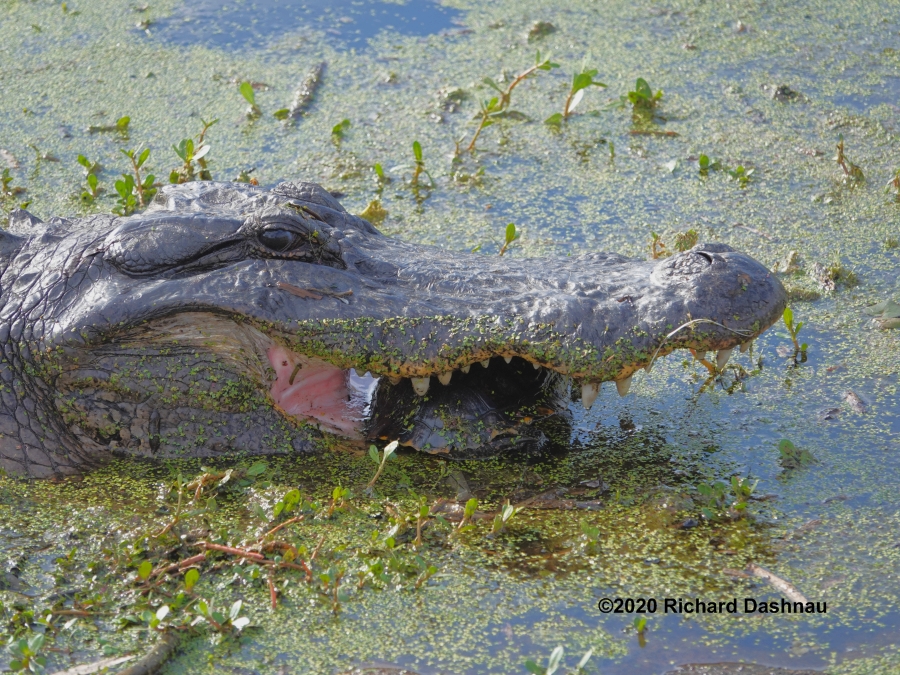
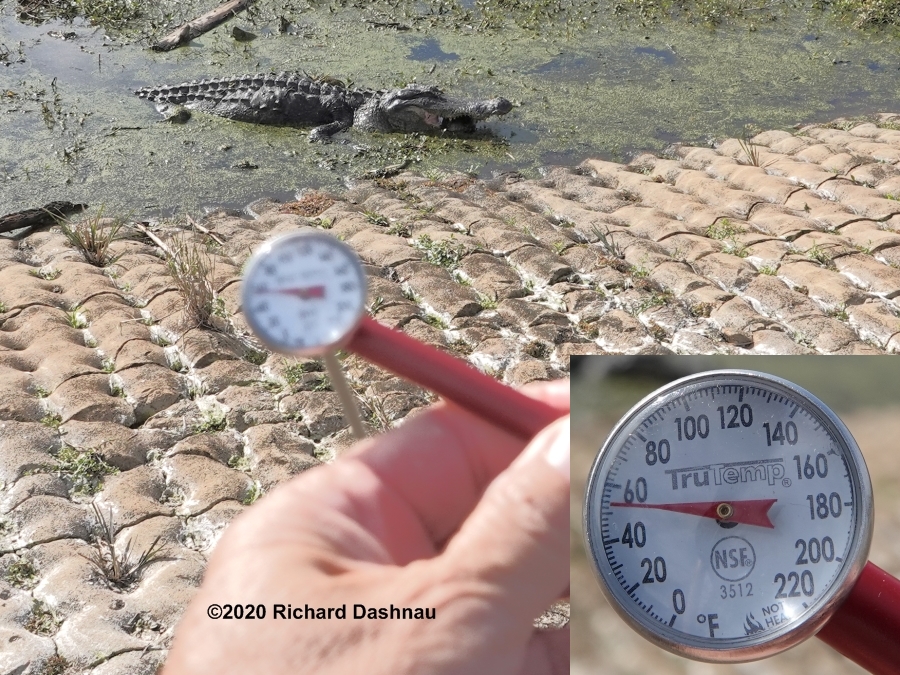
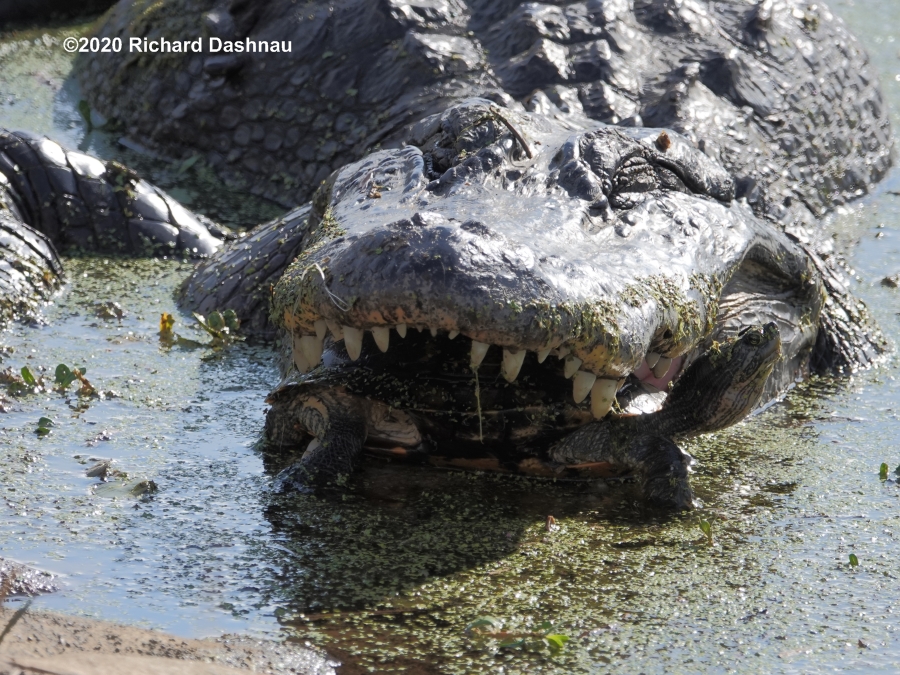
04/21/2019
Alligators impress many people with their size and fearsome
appearance.
People often assume that larger alligators often eat large
prey.
Alligators do sometimes eat large
prey, but prefer to eat prey
that they can catch, process, and swallow easily. Large
prey
items need to be broken into smaller pieces that can be
swallowed. One
method alligators use is
"twist-feeding". The twist-feeding
behavior-sometimes called a "death roll"-is often referred to;
but I
have rarely seen this in practice. Twist-feeding is usually a
reflexive
behavior triggered
by resistance encountered by an alligator when
its jaws clamp on an object. That is, if the alligator
grabs an
object and pulls--and the object doesn't move with the
alligator--the
twist
behavior is triggered.
Alligators are very strong, and
it's a rare object that does NOT move when an alligator tugs on
it. Alligators will eat prey of all sizes, and
occasionally they
will find something that cannot be
swallowed whole--even after a
long day (or more) of chewing on it. When this happens,
the prey
has to be broken up somehow, but twist-feeding won't work
because the
prey is too
small--it just spins with the alligator. So, an
alligator uses a combination of chewing and prey-whipping to
fragment
the carcass. This involves crushing the carcass with the jaws
alternated
with periods of rest. Rest periods with no movement can
be 5 to 30 minutes long. During this time, the carcass is
occasionally repositioned in the jaws. This allows the entire
carcass
to
be crushed over time. Eventually, the alligator will
begin to "whip" the carcass. To do this, while pushing up with
its
forelegs, the alligator lifts its head (and the carcass) as high
as
possible.
Then it turns its head to the side, which moves
the carcass into position for the "throw". The alligator
lets its
body fall forward and to the side (opposite to the direction it
turned
its snout).
Suddenly stopping the body's forward motion, the snout
(still holding tightly to the carcass) is flung forward across
the
body. This slings the carcass around in an arc. As the
carcass
moves
across, the snout is then jerked back the the other way--along
with shifting the body. This pulls the clamped portion of the
carcass
back while the far end continues in the direction it had
started. Slack
disappears and the portion clamped in the jaws is pulled sharply
against the mass of the traveling carcass in a "whip-crack"
effect. Over time, as the carcass is weakened,
the carcass
eventually pulls apart, and the alligator is usually left with a
portion
of the carcass still in its jaws. Once the form of the
carcass
has been compromised (the skin which had held
it together is torn) it
becomes easier to turn into fragments small enough to swallow.
I
have not been able to find any account of this prey-whipping
process in
"the literature" anywhere, so
the previous description is from my own
observations over the years. On April 21, 2019, I was able
to watch an alligator with the carcass of a nutria--for about 2
and a
half hours. During
this time, I was able to watch the alligator, and
share the experience with the many park visitors who came by.
The
alligator was close to the long bridge over the Spillway.
During
that time,
I observed many repetitions of the activities described
above--and was able to document some of them with bursts of
photos, or
video shot at normal frame rate (60fps) and high frame
rate (480 fps). Those photos and clips appear in this video (mp4). The images below are
from one of the "burst" shots of photos. I have some good
examples of twist-feeding and
prey-whipping on this
page( there's twist-feeding used on a deer carcass; and
prey-whipping of nutria) ; on this page (a large fish is
whipped); on this page
(an alligator carcass is
whipped); this page
(another alligator is whipped); and finally this
page (another alligator carcass is whipped).
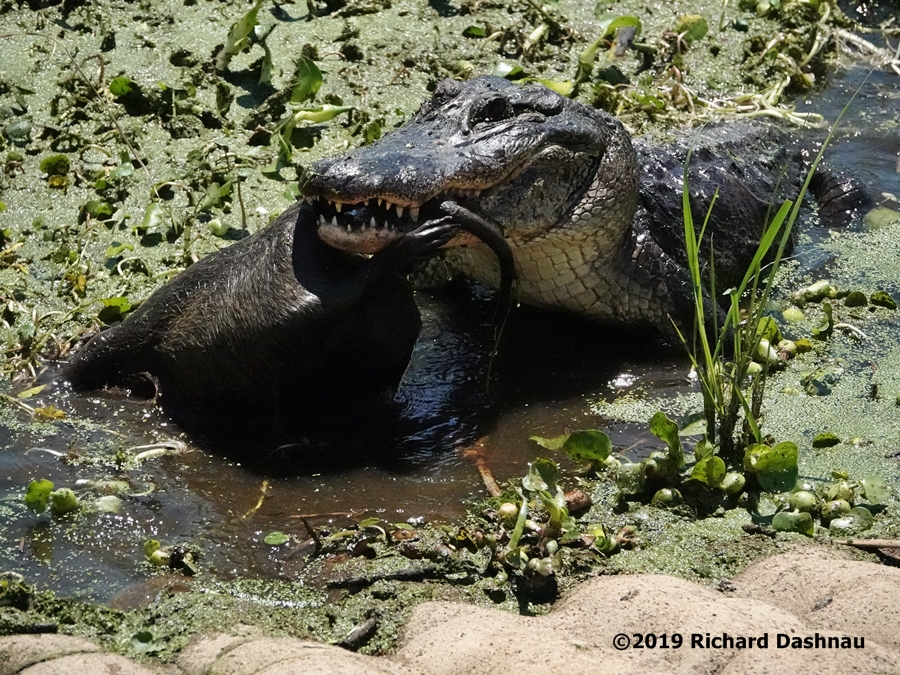
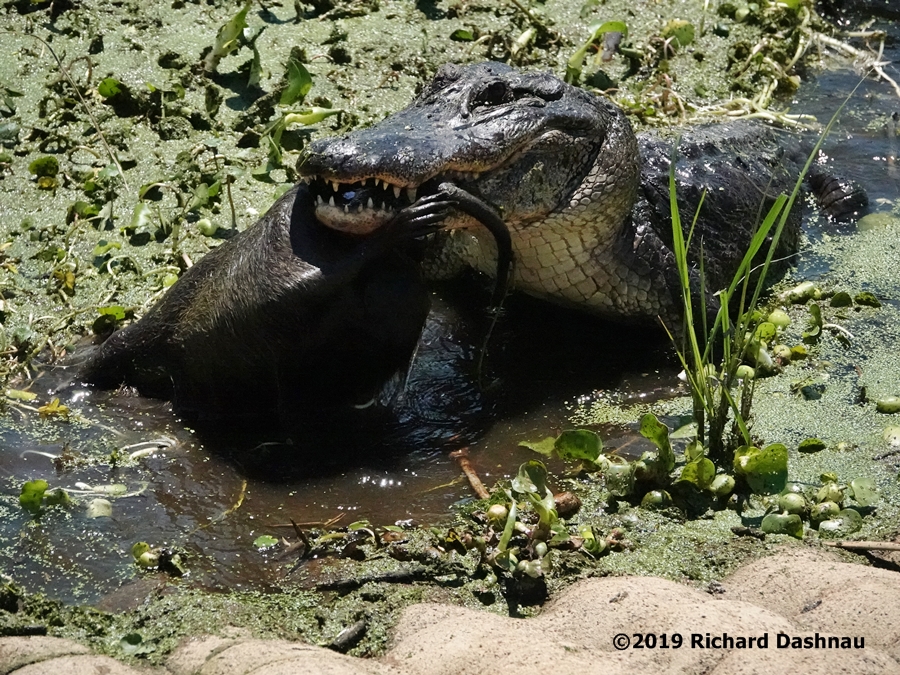
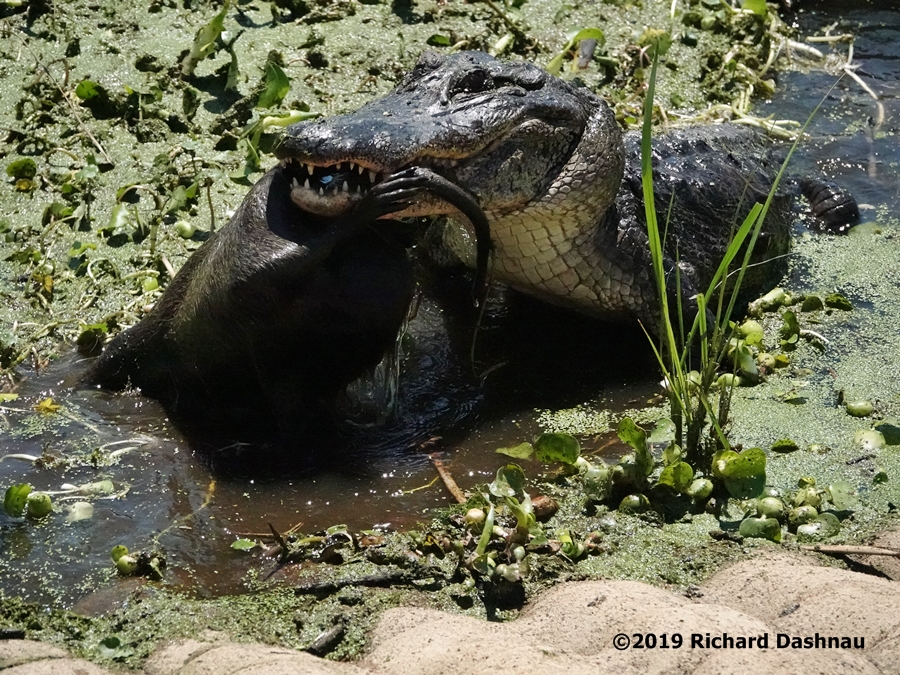
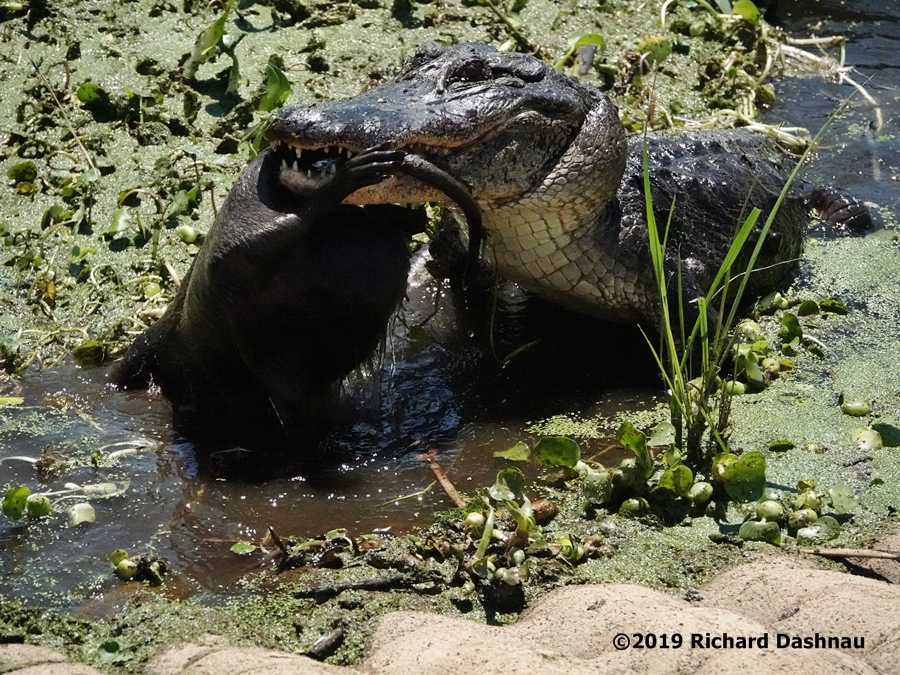
Lift 001
Lift
002
Lift
003
Lift 004
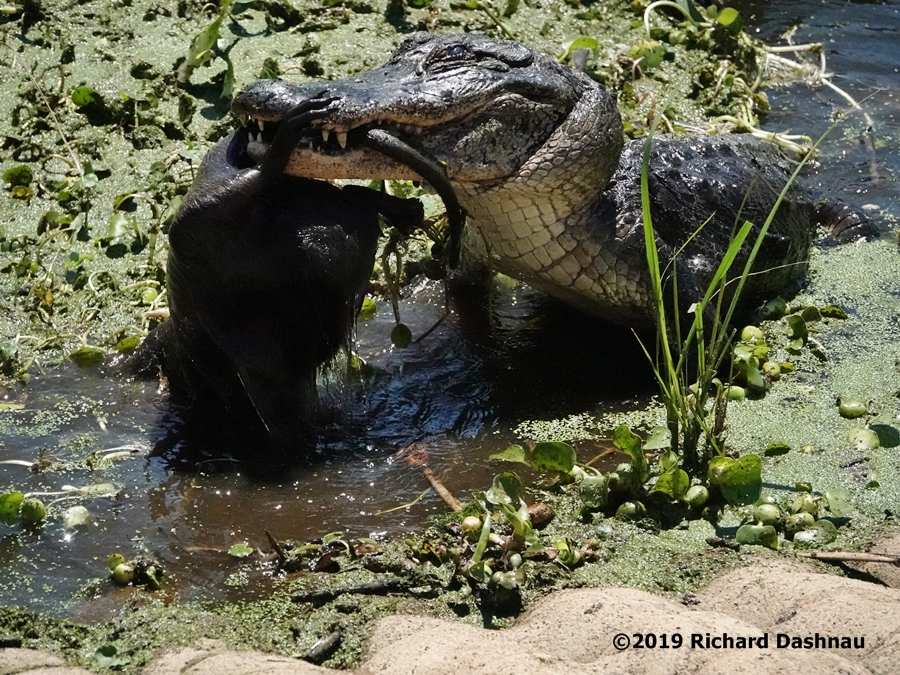
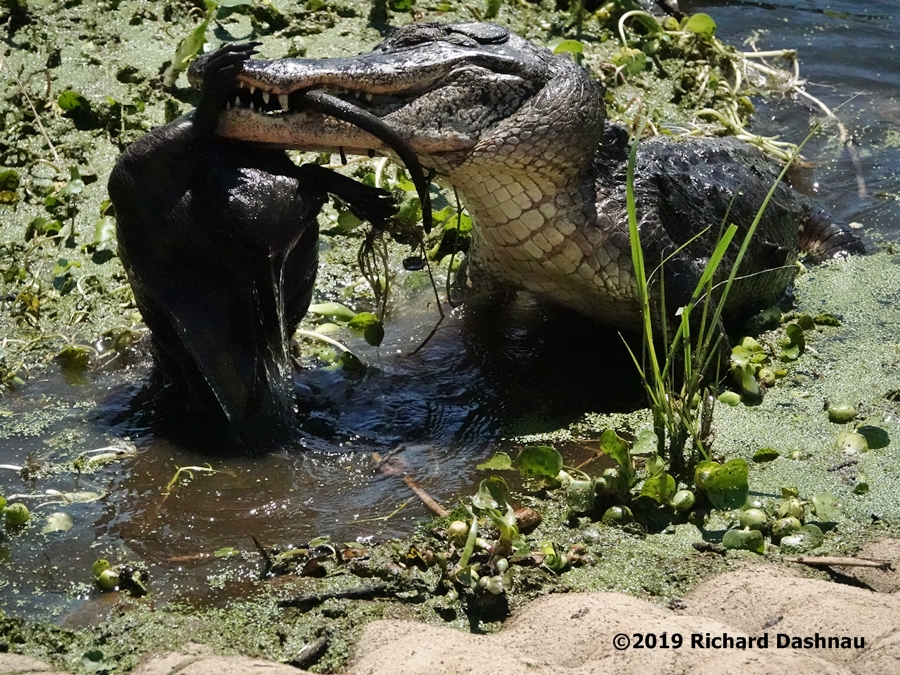
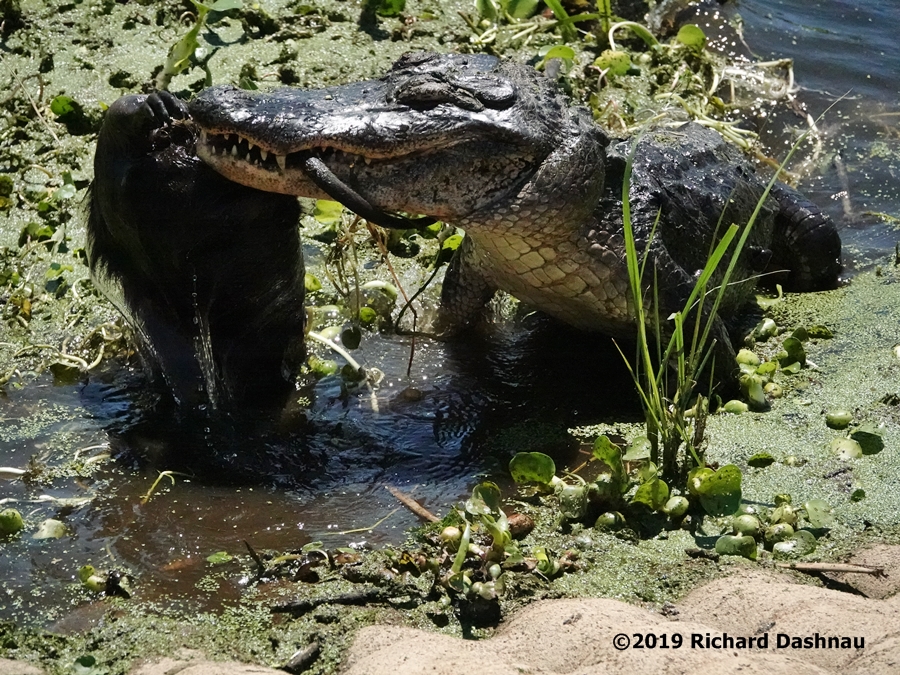
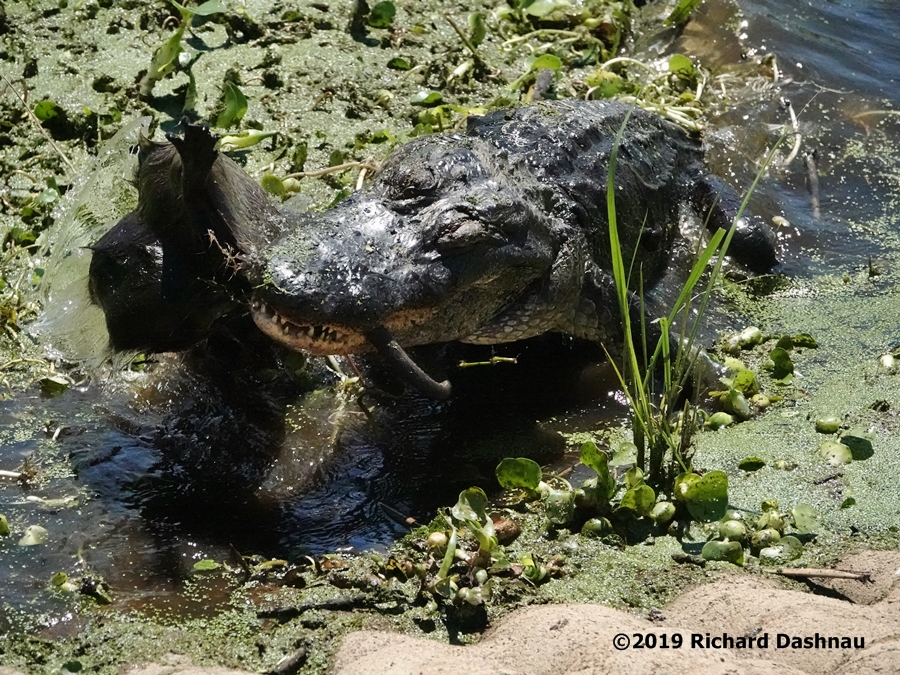
Prepare to
throw
01
Prepare
to throw 02
Drop
and throw 01
Drop and throw 02
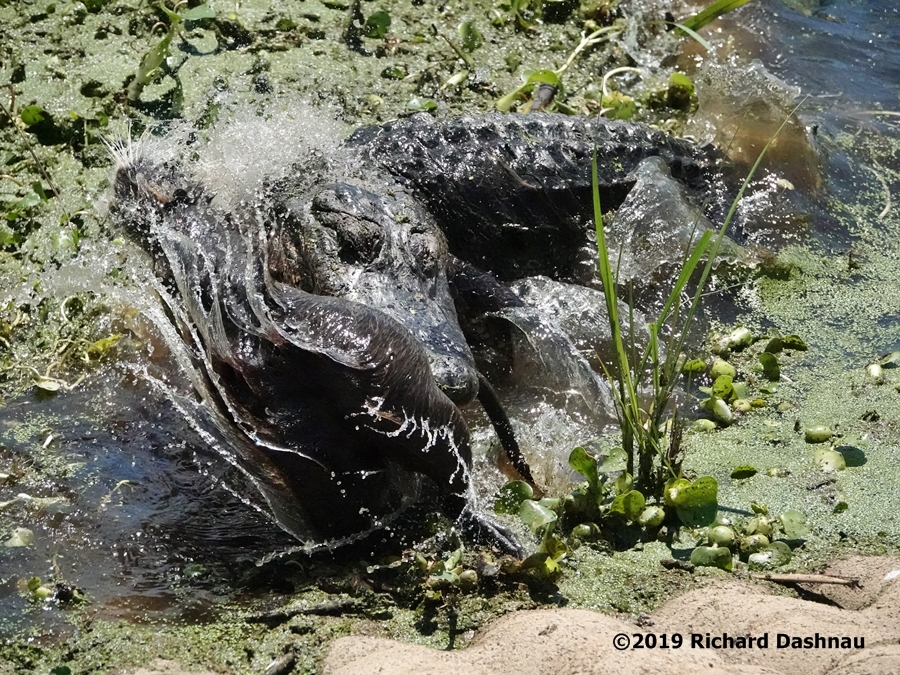
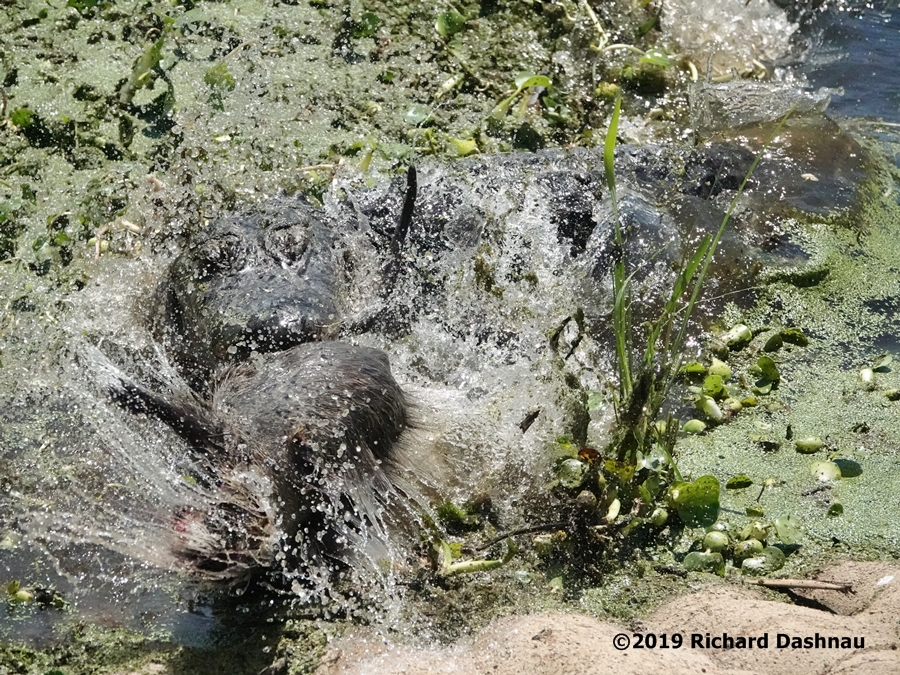
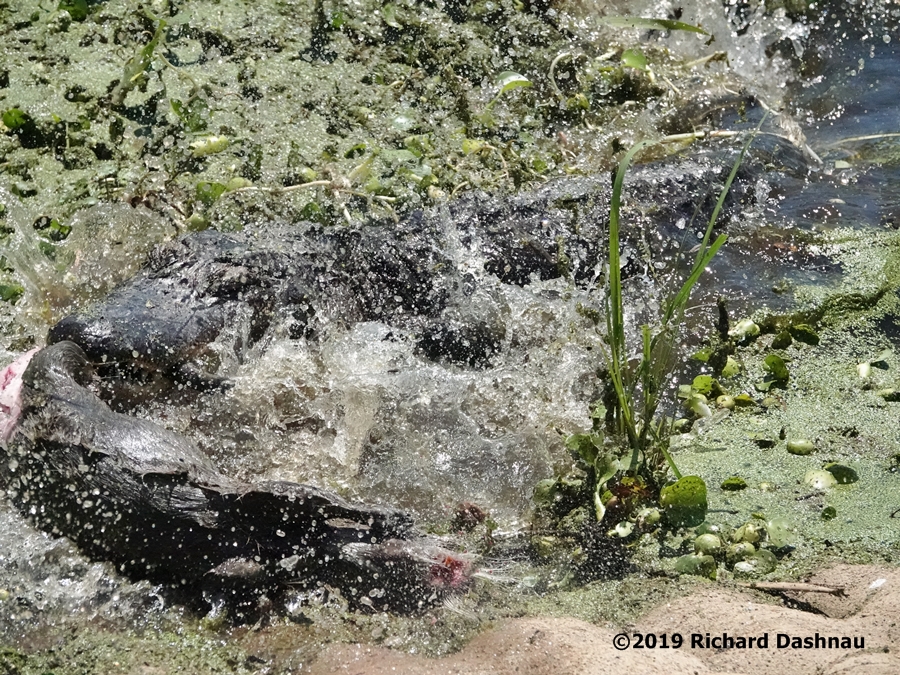
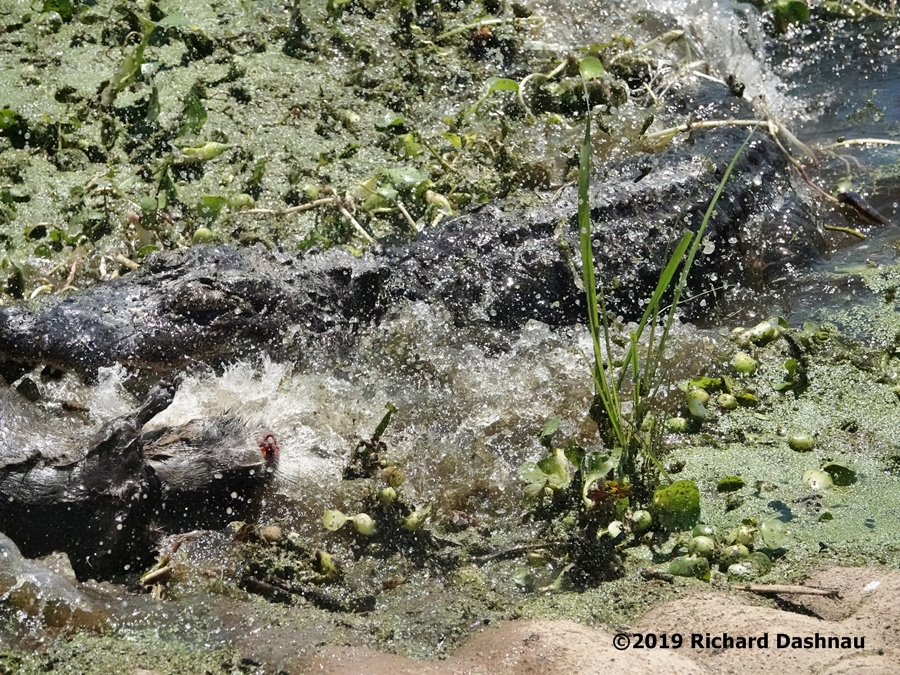
Drop
and throw 03
Pull
back and whip 01
Pull
back and whip 02
Pull back and whip 03
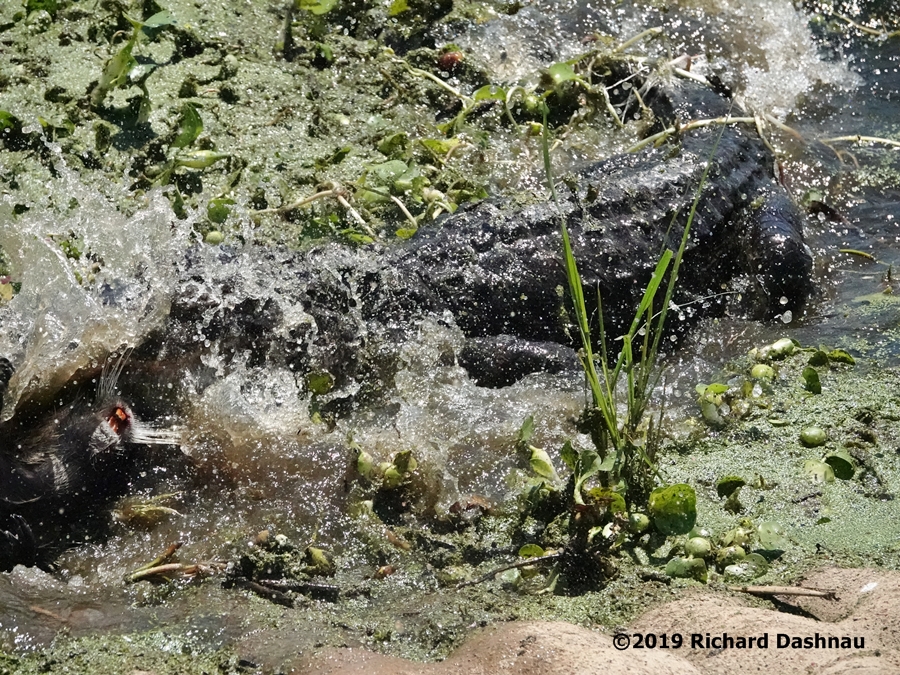
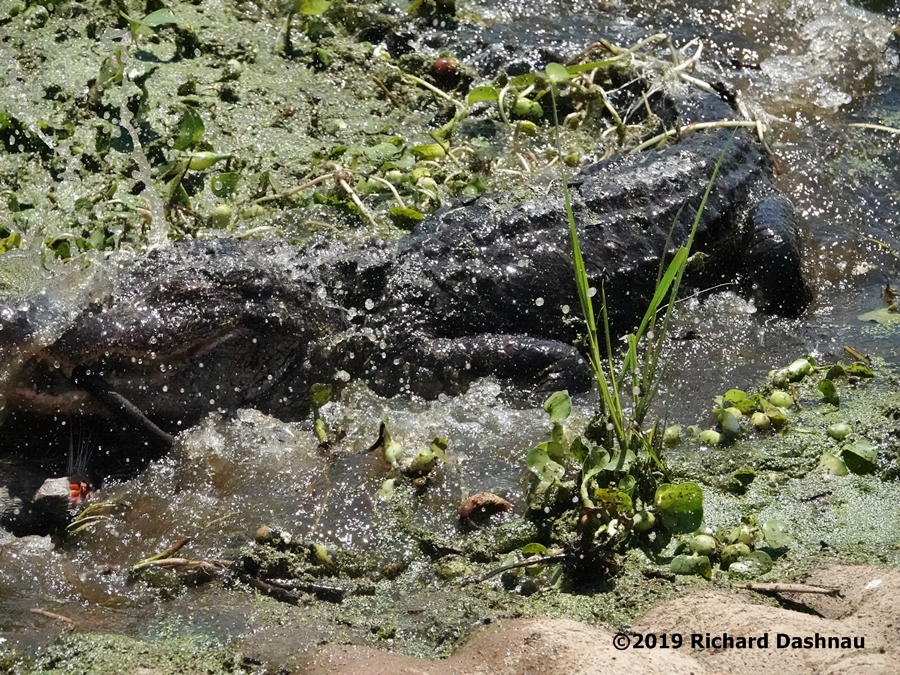
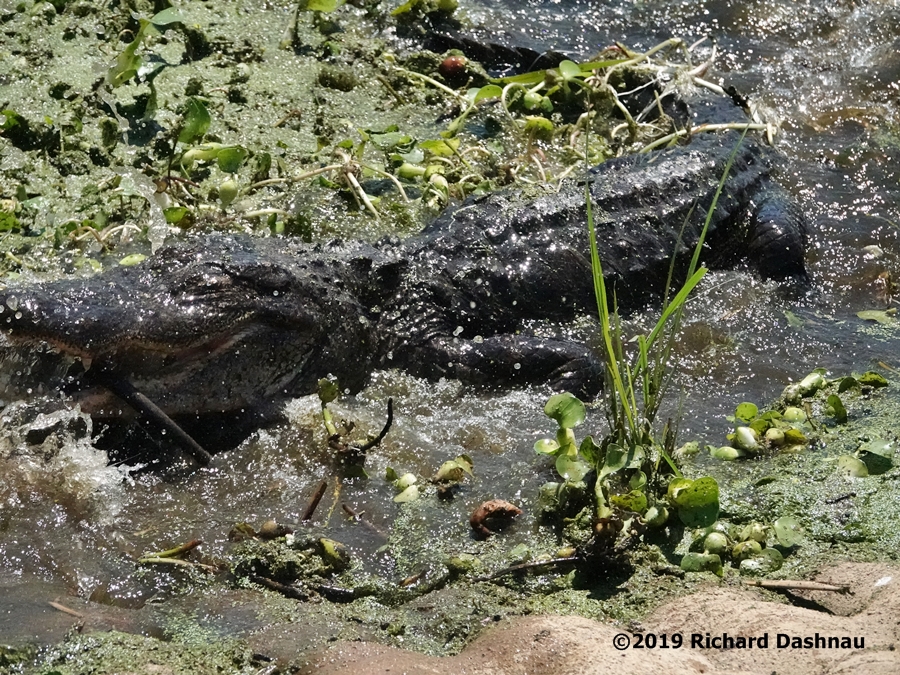
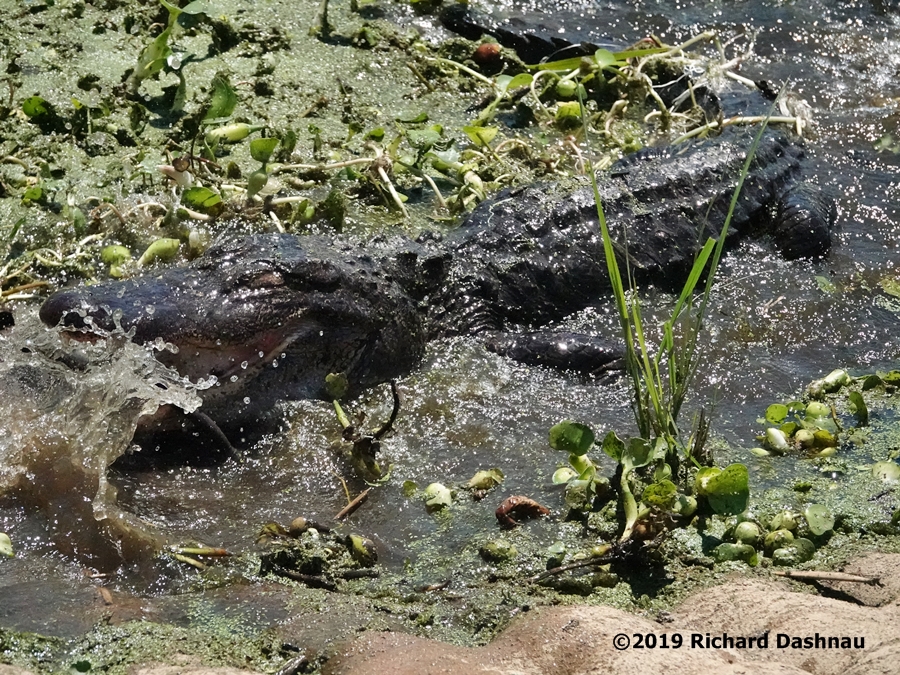
Allow the carcass to stop 01
Allow
the carcass to stop 02
Allow
the carcass to stop 03
Allow
the carcass to stop 04
This
nutria carcass did eventually start to tear, but I probably
won't post
those pictures here (although it does show in the video).
Soon
after that happened, the alligator
moved off with the nutria, and I didn't see any more of it.
09/23/2018
I saw another group of alligators feeding at BBSP this
morning.
As I've seen before, the water had a lot of plants growing under
it and
on the surface. The were alligators
scattered about, and
occasionally one would rear up and pounce at some
unidentifiable
prey. The images and video are somewhat dark because this
activity was
happening in the shade,
at about 9:00 am--and alligators dispersed at
around 10 am.
I believe that all of
this is the result of
excessive oxygen consumption overnight by the aquatic plant
life. This
causes a low oxygen condition in the water, which would
drive fish
to the
surface; where the alligators (and other predators) are
waiting. As the sun rises
higher in the sky, more plants are exposed to the light, and
the oxygen
levels begin to rise. The fish stop
coming to the surface, and the
"party" breaks up. At least, that's my theory. Over
the years,
I've received many reports of these "gatherings" while on
the
trails--and they've often been
over by the time I made it to
the
area. Also, the few times I've witnessed a gathering
myself, the
gathering has broken up as I've described. I submit this
hypothesis as
an explanation.
I have another example of
such a gathering in this video
clip--shot earlier this year(mp4)--5/27/18.
Someday, I'll expand the story onto a page here. There's a lot
happening in the video,
and it's worth a look. If you look at
that video clip, notice the surface of the water...and compare
it with
what's here. The high density of floating plant life shows in
both
cases.
The images below are from this short video clip(mp4)
that shows some of the alligators in action. These images
show
how an alligator uses its tail as a brace for a backwards grab.
It
starts pushing against the water sideways while turning back
with its
head.
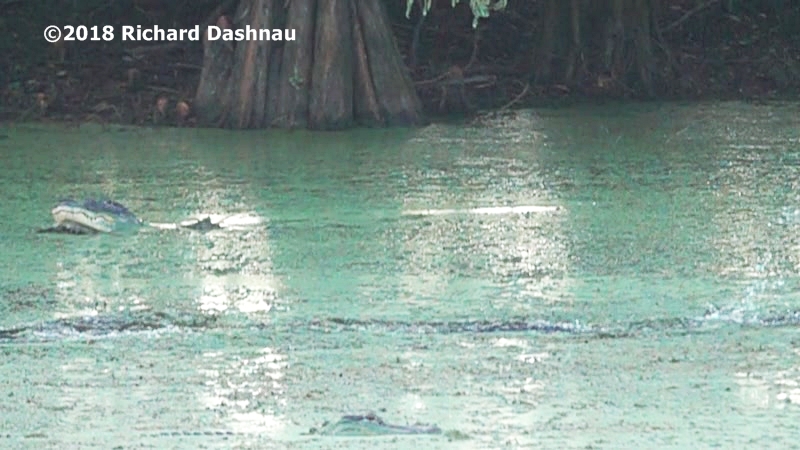
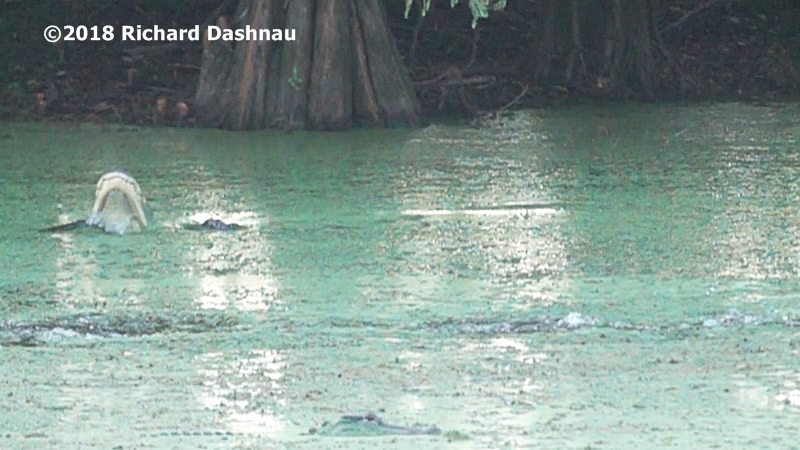
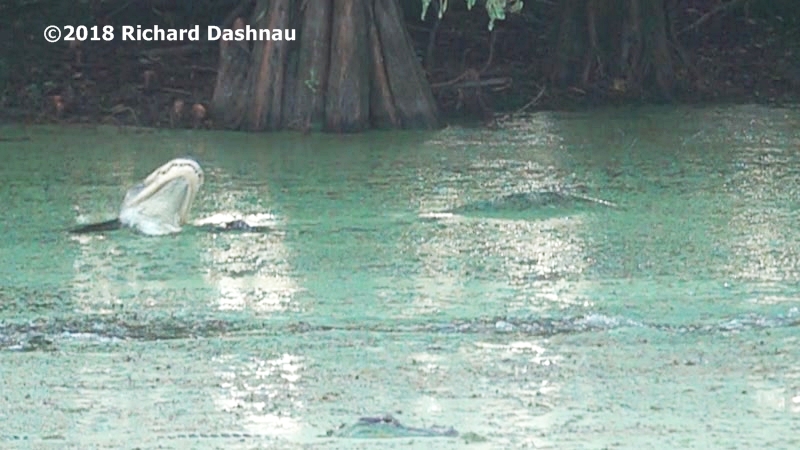
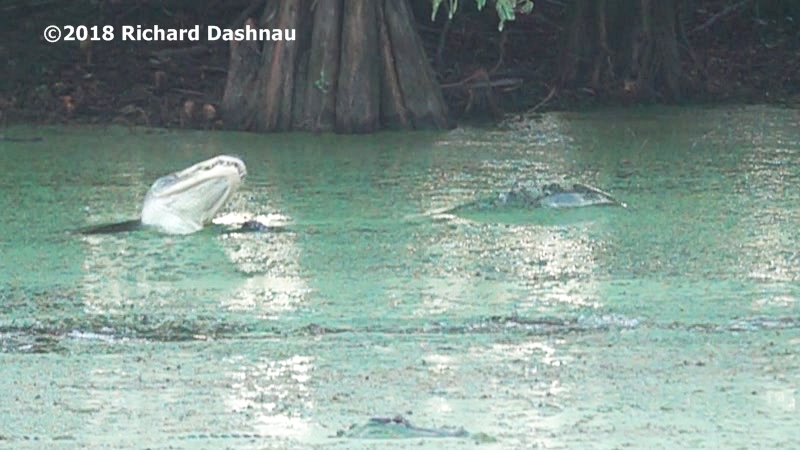
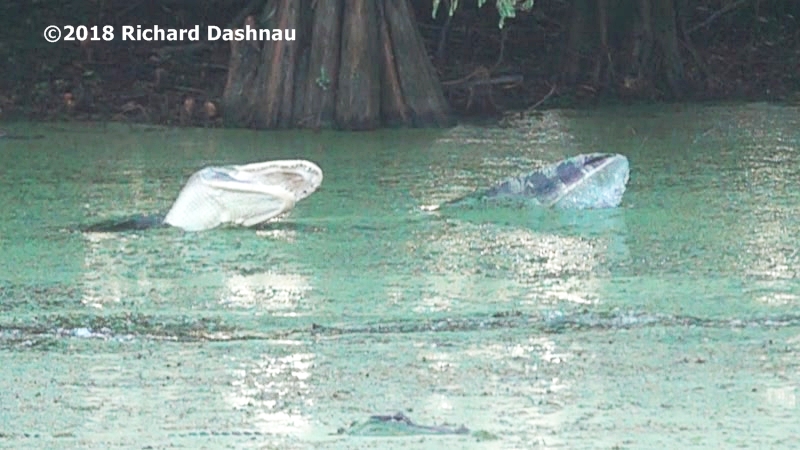
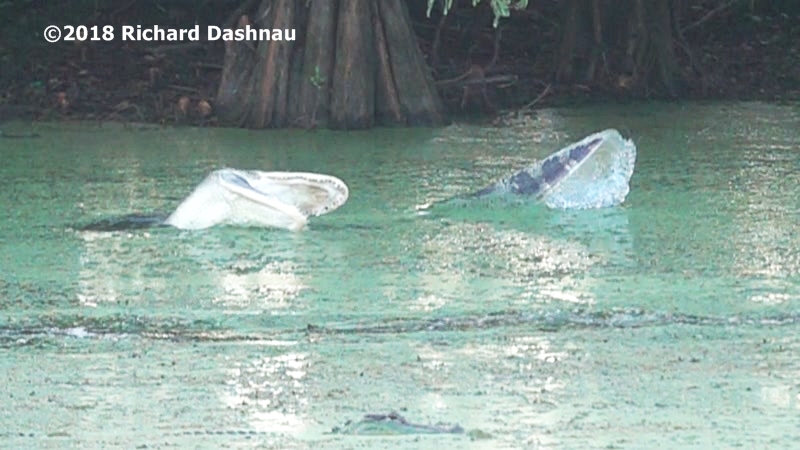
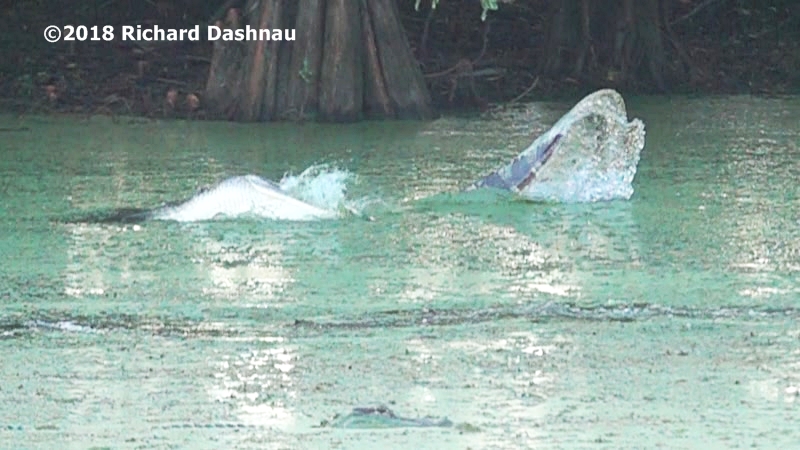
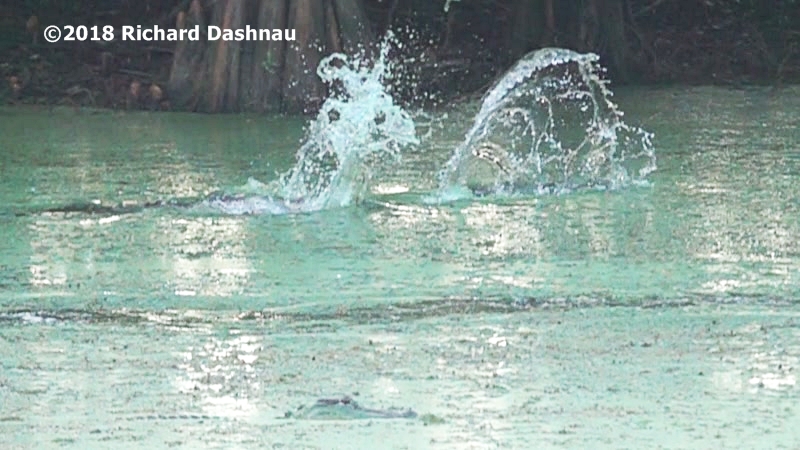
01/21/2018 . I
was on the North loop 40 Acre Lake trail, not far from the
Observation
tower, when I noticed movement about 75 yards away on one the
the
islands. When I checked through
my binoculars, I saw that it
was an large alligator--I estimate at least 6-7 feet
long--with a
large fish in its mouth. I say *large* fish, because I could
that
something hanging from the alligator's
jaws from 75 yards away without
visual aid. Only with binoculars could I tell it was a fish. I
moved a
few yards closer, but wanted to maintain a profile view.
Then I
watched the alligator for a
while as it worked on the fish. As usual, the
alligator occasionally lifted its head, crushed and/or shook the
fish,
and then rested for 15 minutes or so before doing it again. I
watched
the
alligator for about 45 minutes, until it had all of the fish in
its jaws, then moved onto the island to rest.
The images
below
are photos--and some frame grabs from the video I shot.
The video is here(mp4).
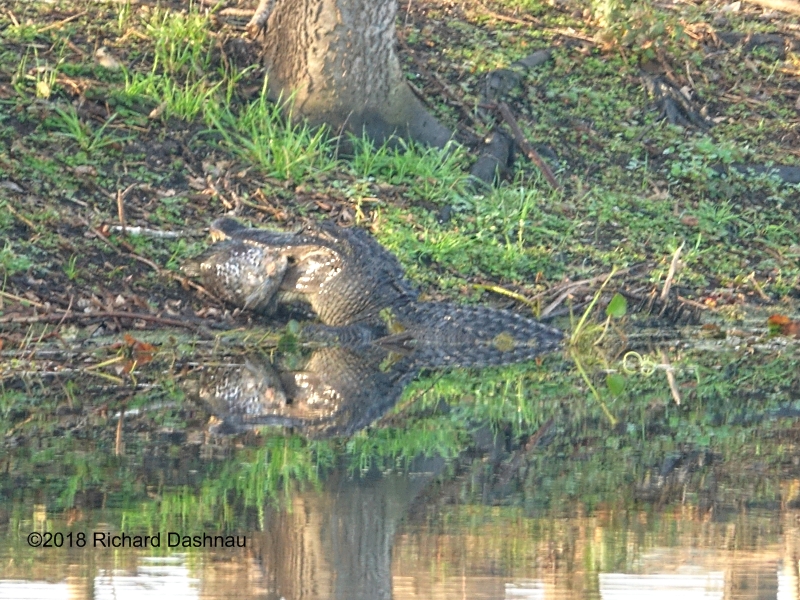
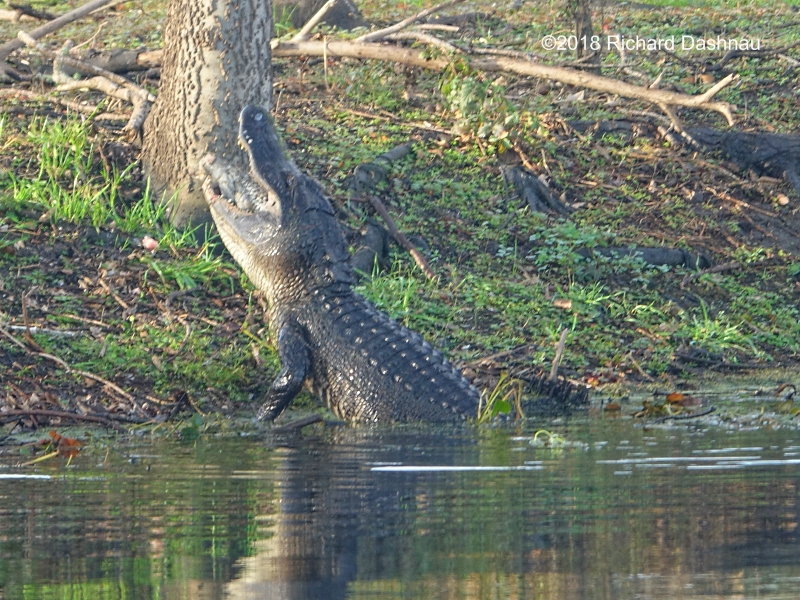
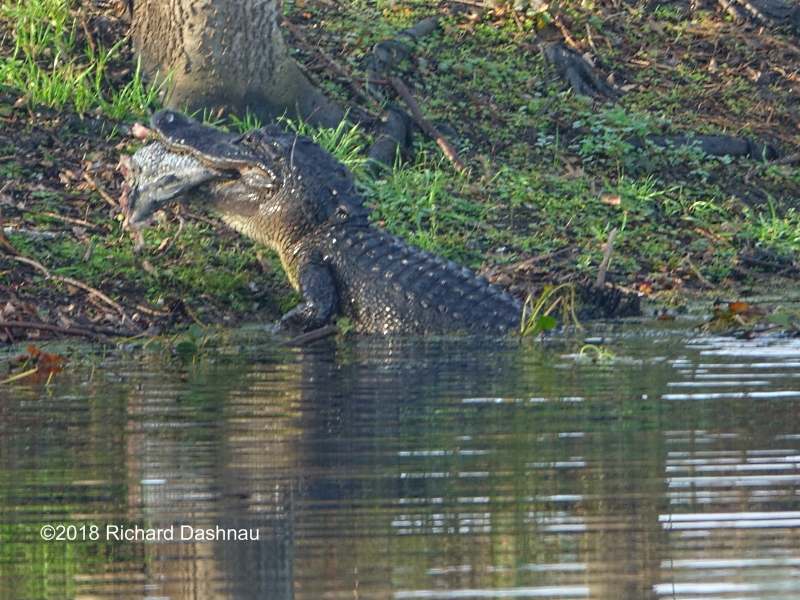
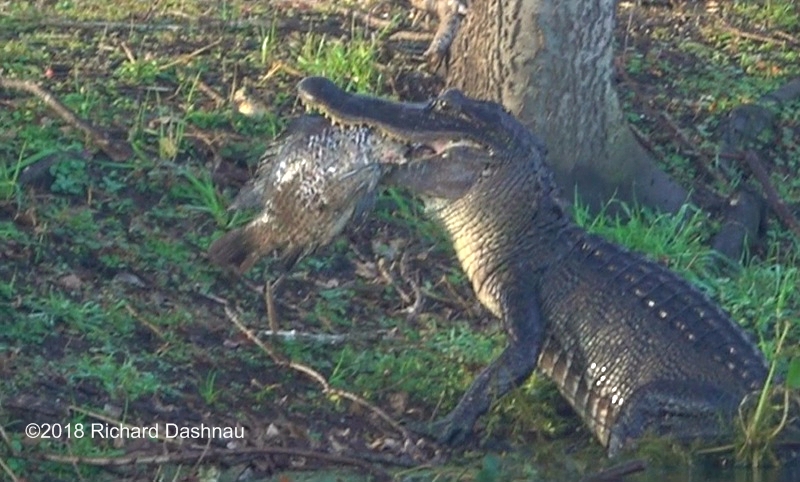
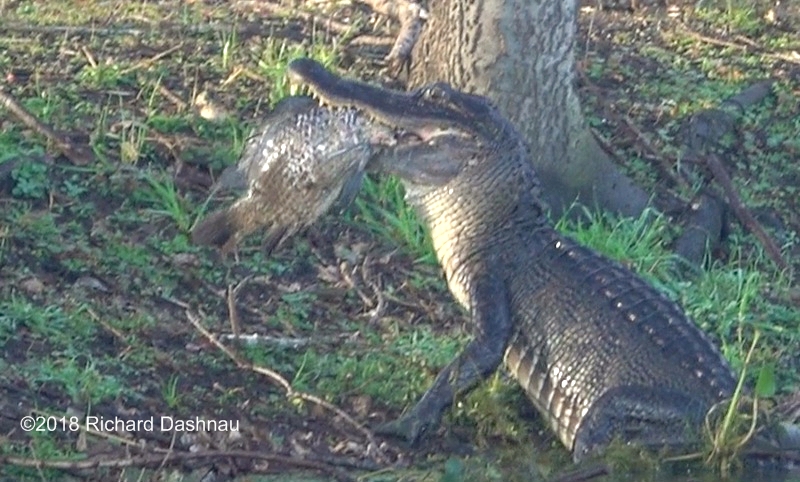
They
are cropped, and at least show what the alligator was up to.
Also...the
fish is NOT a gar, or bowfin, but flattened from the sides (like
a
bluegill). The cropped video is a bit clearer, and
it looks to me
like both the dorsal fin and the anal fin have long trailing
edges.
That makes me think the the fish is a very large tilapia. (this
is a blue
tilapia ) Tilapia are invasive in Texas
waters...so
GO GATOR!! But...hold on a minute. Hadn't we just
had a
couple weeks of near-freezing temperatures (within 10 degrees
above
and below
32 degrees F-see graphs from about 6
mi. from BBSP below)? And aren't alligators ectothermic
(or poikilothermic)?


Isn't
it true that an alligator's internal temperature needs to be
around 70
F for its metabolism to work properly...such as in digestion--or
even
moving around? What the heck is motivating that
alligator? Well...the
air temperature I measured while I was watching the alligator
was 60 F
and rising ( I often carry a thermometer in my pocket--and yes I
let it
cool down in the air before
reading it.) Also, I have no idea what
the water temperature was. I can only guess that the water
had
become colder than the air, and that's why the alligators were
coming
out of the
water--even though the day was overcast. Some information
can be found in an excellent book published in 2015: Biology and
Evolution of Crocodylians by Gordon Grigg and David
Kirshner. An
entire chapter talks about this: Chapter 10 Thermal Relations
p.337 -
389
Within that is a part relating to American
Alligators: Body Temperature Patterns in the American
Alligator
p. 355 which relies heavily on this
study:
"Body
Temperature Null Distributions in Reptiles with Nonzero Heat
Capacity:
Seasonal Thermoregulation in the American Alligator" which I
found here.
This is from the book:
There
are many ways for thermal energy to transfer to and from an
alligator. "In most crocodylians, the sun is their
major
source of warmth and they use it or avoid it
in diverse ways, some
quite subtle." (P. 360) Crocodylians heat more
rapidly than
they cool (p. 362) through control of blood flow.
1)
basking --moving in and out of water--energy from sun,
conduction from
warm air, water, or ground. but they can also adjust the
rate of
change by how much of the body is submerged (p. 361)
2) There
is good evidence for use of osetoderms as "solar panels"
. They
are suffused with blood vessels and do gather heat. (p.
362)
3)
Gaping has negligible effect on overall body temp, but does
function
well to keep head temperature stable. The Head can also be
cooled by
evaporative cooling thru moisture in the
nasal passages. (p. 371)
Basically,
what I'm saying here is that there is a complex relationship
between
environmental conditions, alligator size, and alligator behavior
that
controls how warm an alligator might be.
But, I suspect that
still doesn't explain how this (or other) alligators have been
observed
being active (and feeding!)
during cold weather.
There's
another very interesting ability that has been observed in
reptiles
(including alligators) that may explain what's going on here. I
first
read about it in a great book about snakes
published in 2014: How
Snakes Work: Structure, Function and Behavior of the World's
Snakes, by
Harvey B. Lillywhite.
I found this on page 110 in that book:
"Preferred
body temperatures of snakes may undergo seasonal changes and
can be
modified by changes in physiological factors or the physical
environment. Acclimation is a reversible
change in a character
that results from a prolonged change in the environment,
especially temperature. In scientific literature, the
term
acclimation refers to such changes when they are
introduced in the
laboratory, whereas the term acclimatization is used to describe such
changes that go forward naturally in a wild animal's
environment."
Acclimatization (with a "z") allows
snakes to function in
temperatures below (or above) their usual range. There is
a limit
to the range of allowable temperature change,
and the length of time this can be tolerated--but it has been
observed.
In
the Crocodylian book, there is also reference to "thermal
acclimatisation (seasonal biochemical adjustments) p. 373" (with
an
"s"). The book states that there is strong evidence that
various
crocodylians use this behavior to function during seasonal
changes.
There is also at least one study available online here:
Seasonal
acclimatisation of muscle metabolic enzymes in a reptile
(Alligator mississippiensis).
There
is still more study to be done about these relationships, but
this is
at least another possible explanation for what we are seeing
here
during the winter.
April
19, 2015--
After the heavy rains that came last Friday and Saturday, I was looking
forward to seeing what BBSP looked like. I wasn't disappointed. Water
levels in the lakes high, and
water moved slowly under the Spillway
Bridge, since Pilant Lake was almost the same level as Pilant Slough.
All the rain probably lowered the general water temperature; and it
also covered
much of the lower banks of the islands and around the
lakes. And the Sun was bright. So....this meant that many alligators
were out of the water, and near the trails. There were many
sightings
of alligators crossing trails. During
conditions like these, it is especially important for visitors to be
aware of "alligator etiquette", and there are many opportunities for
"teachable
moments"; especially for those of us doing Trail
Interpretation. After all, we are right there with the alligators and
the visitors at the same time.
The two photographers were actually
concentrating on a large alligator on the bank of Elm Lake when this
one began crossing the trail behind them. I called out an alert, and
they turned
around to watch (and film) the crossing. Meanwhile, the
gator crossed until it got close to the other, larger one. *I* expected
some kind of interaction, but nothing immediately happened. But,then,
without any signal I could see (otherwise I'd have filmed it), the
large one rushed the smaller one (still about 7' long), causing it to
submerge and swim off. This sudden burst of motion is hard to
catch
(because there isn't much warning), but is a definite demonstration of
how quickly an annoyed gator can move. The larger gator returned to the
bank, but not before lying in the water and
swishing end off its tail
back-and-forth (much like an annoyed cat does), before it slid back up
on the bank. It appeared that it just wanted the nice basking spot for
itself--no sharing. I've
edited photos and video into short clips: Click the link to see
it--Gator
Walking(mp4)
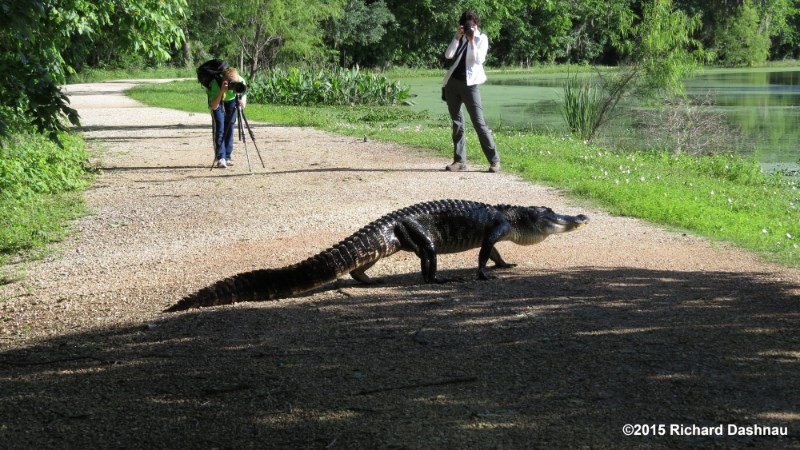
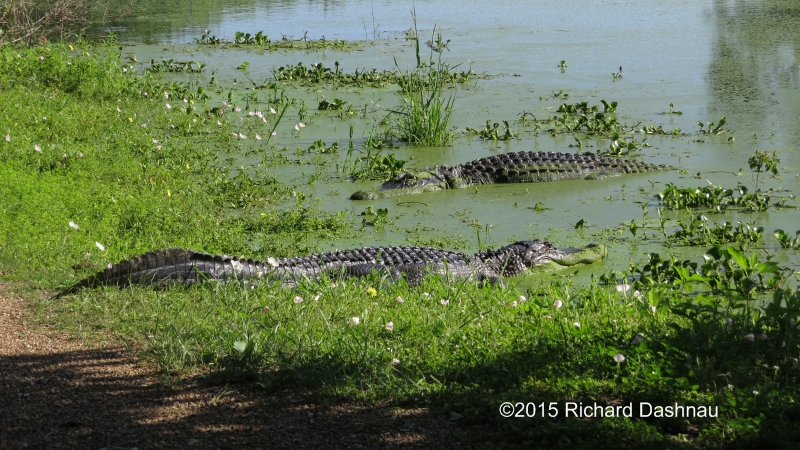

MORNING WALK ON THE TRAIL
WATCHING THE ONE ALREADY THERE
ANNOYED
AND THRASHING TAIL
Then
there was the group of gators in front of the composting restrooms. The
new front deck made a handy path around the gators. There, also, was a
nice shallow bank for the gators to bask on.
I saw another minor
disagreement between 2 gators there, also. When one of the John
Deere vehicles drove by, 2 of the alligators slid into the water. But ,
after just a few minutes, one of the gators
slid back up on the grass.
However, this was in the spot where the larger gator had been basking.
The larger alligator came back to the bank, and looked at the gator on
the grass for a few minutes.
When the staring didn't work, it
moved into "head oblique/tail arched" posture...and then did a loud
headslap. This did not impress the other alligator, which gave a low
growl. The larger gator then
settled for moving up onto the grass right
next to the "good spot:" I've edited photos and video into
short clips: Click the links to see it--Gators
Basking-argue(mp4)
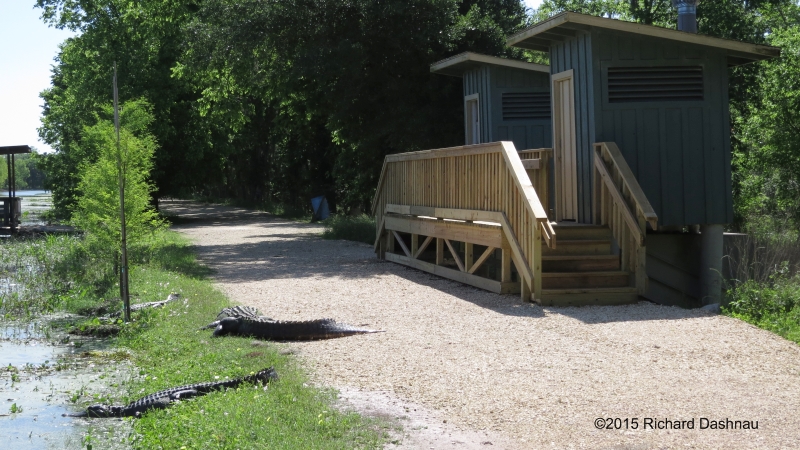
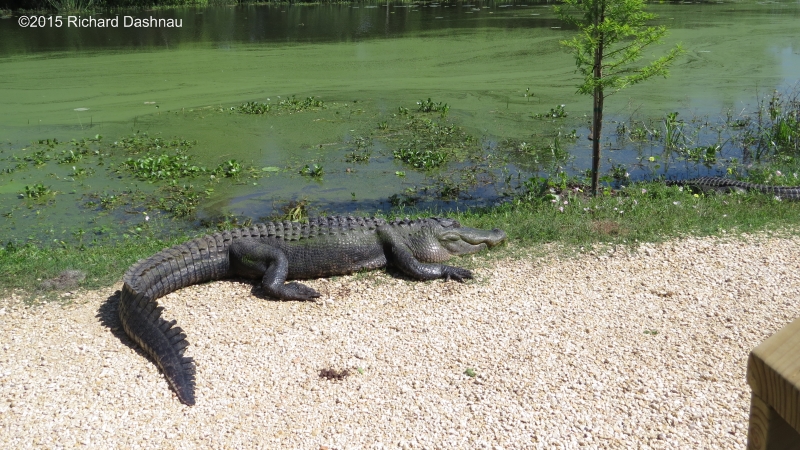
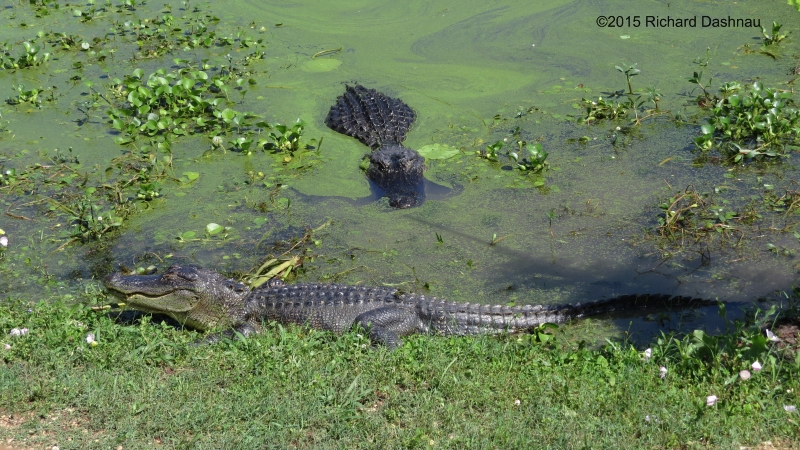
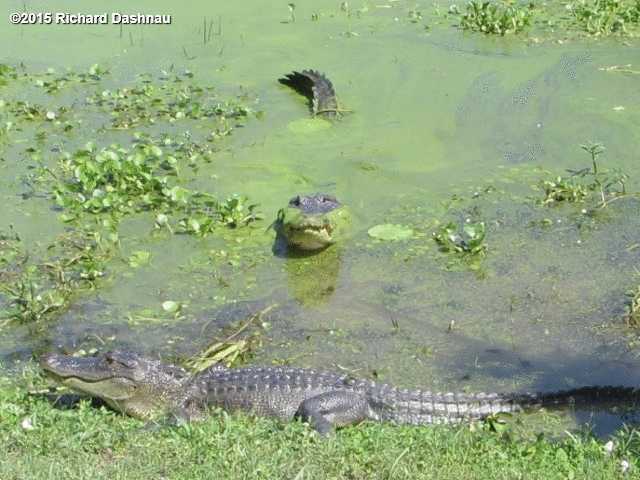
GATORS BY
THE BATHROOMS
LOOKING DOWN FROM THE DECK
HEY! YOU TOOK MY SPOT!
THE HEADSLAP
Then
at about 12 pm, I was on walking towards New Horseshoe Lake when I
noticed a group of about 10 people looking down into the lake. When I
got there, I saw that a large alligator had a deer
carcass in its jaws.
I was happy to see that most of the park visitors were giving the
alligator a lot of room. I watched and was able to talk about how
the alligator would probably deal with the carcass
(it was NOT a small
fawn). I didn't see many other alligators around, but there was another
large on on the bank nearby. I suggested that the gator with the
carcass was probably trying to leave the New
Horseshoe to get into
Elm...mostly to keep the carcass for itself. I also told those visitors
who remained nearby that the we should stay out of the direct path of
the alligator, and give it lots of space.
If we did those things, we'd
probably see the alligator cross with the carcass. And...the alligator
*did* start across....a couple times. But each time it lifted its head
(with dangling carcass) and began to
walk, it would step on the
carcass....and of course didn't get far. Then it would stop and rest a
few minutes more. Finally, the alligator did an odd sort of "plowing"
movement and pushed the carcass
and slid it forward.
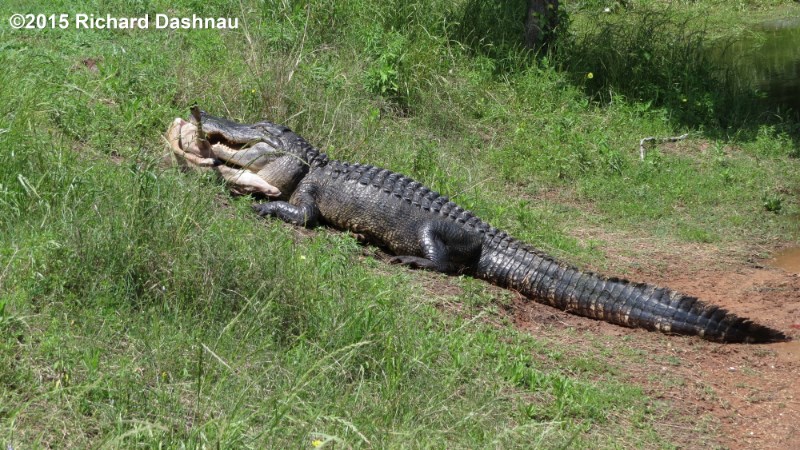
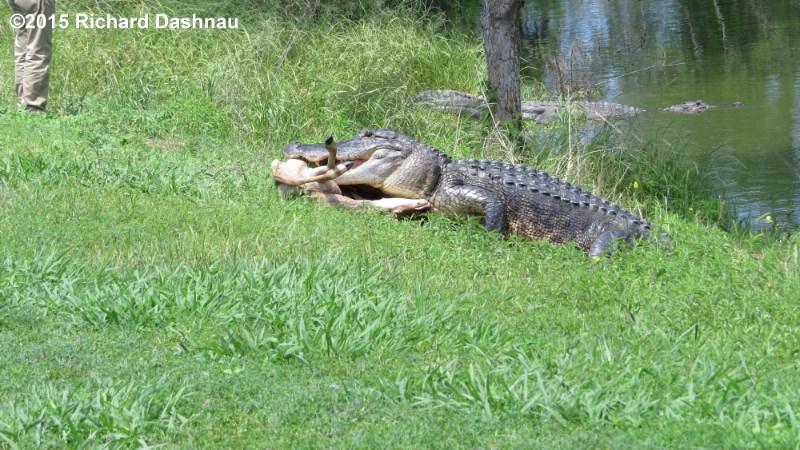
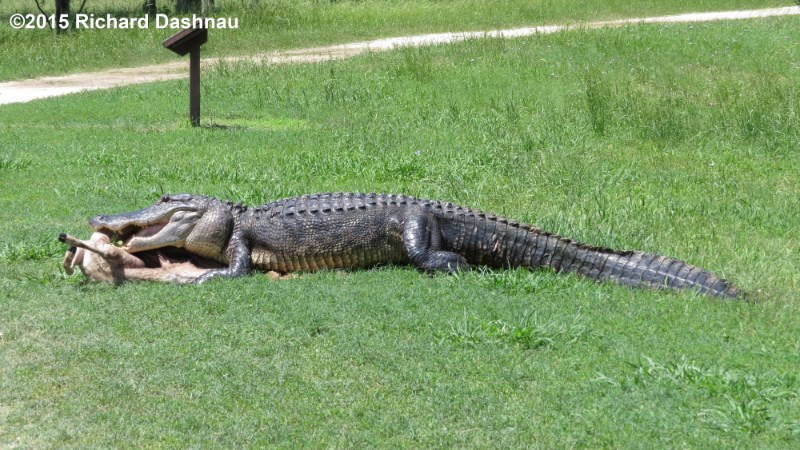
NEARER THE WATER IN NEW HORSESHOE LAKE
MOVING UP ONTO THE LEVEL GRASS
STARTING TO
SLIDE ACROSS THE TRAIL
The
attached pictures show some of this...and I attached the animated gifs
to show the movement. During all of this, I was able to share my theme
of how alligators don't have it easy--even as "apex predators".
I
pointed out the effort the alligator was expending just to keep its
meal--and also that it could take days for the gator to even be able to
get it into pieces small enough to eat.
The alligator finally got
into Elm Lake, and swam off with the carcass. One thing I forgot to do
was take an immediate length estimate by using my walking stick. But,
compare the length of the alligator with
the width of the trail. I
thought the deer was surprisingly large, and could only guess at how
the alligator had gotten it. The carcass didn't stink, and there were
no flies on it--so it wasn't too old. Maybe the
high water trapped the
deer? I've edited photos and video into a short clip:
Click the link to see it--Gator
with Deer(mp4)
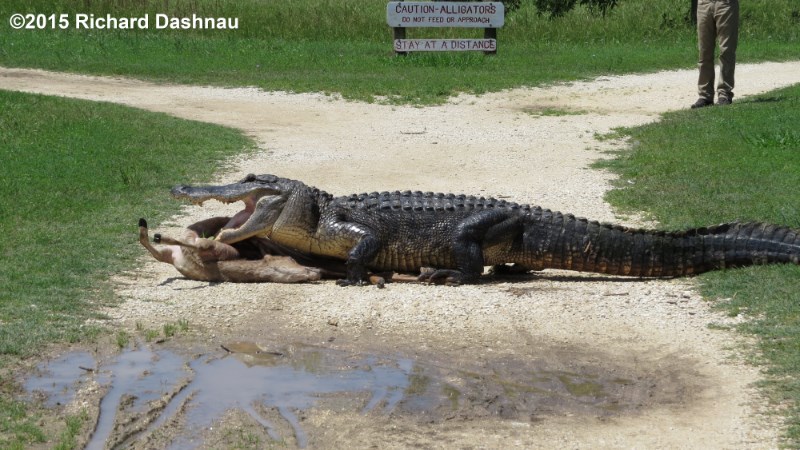
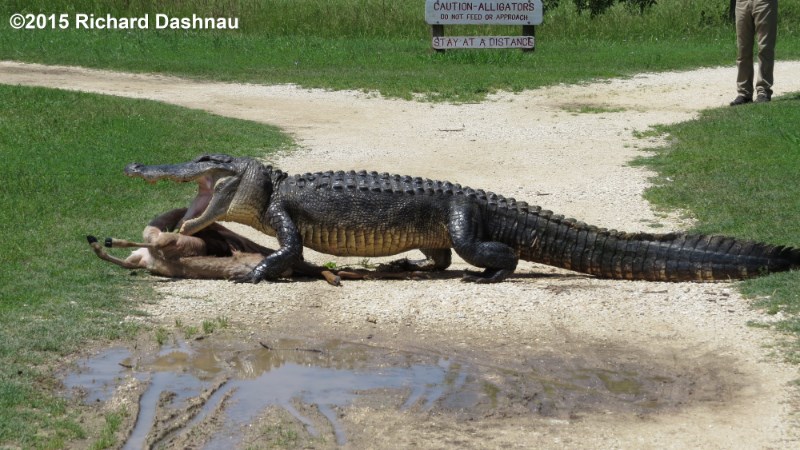

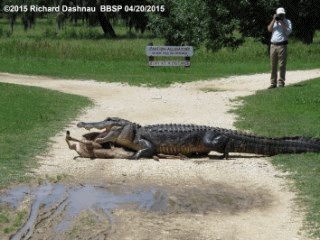
CATCHING WITH THE LOWER JAW
STANDING UP TO PUSH
FIRST PART OF THE SLIDE
SECOND PART OF THE SLIDE
All
of this happened in just ONE day! It was great!
March
1,2015--
It was cold and raining, and generally uncomfortable outside. The
near-80's weather that we'd had a week or so before had gone away. As I
stepped on to the Spillway Bridge, I found this alligator
with a small
nutria in its mouth. After one shift in position the alligator didn't
move again. When I left it, I walked to Elm Lake; and around Elm Lake.
When I retured along the bridge, hours later, the alligator was in
the
same postion as when I had left it. I suspect that the lower
temperatures slowed the alligator's movements. I've seen an alligator
work on a nutria for hours!
While I was at Elm Lake, I stopped at the Observation
Platform,
where I saw a bright red Vermilion Flycatcher that seemed to glow in the
overcast grey air.
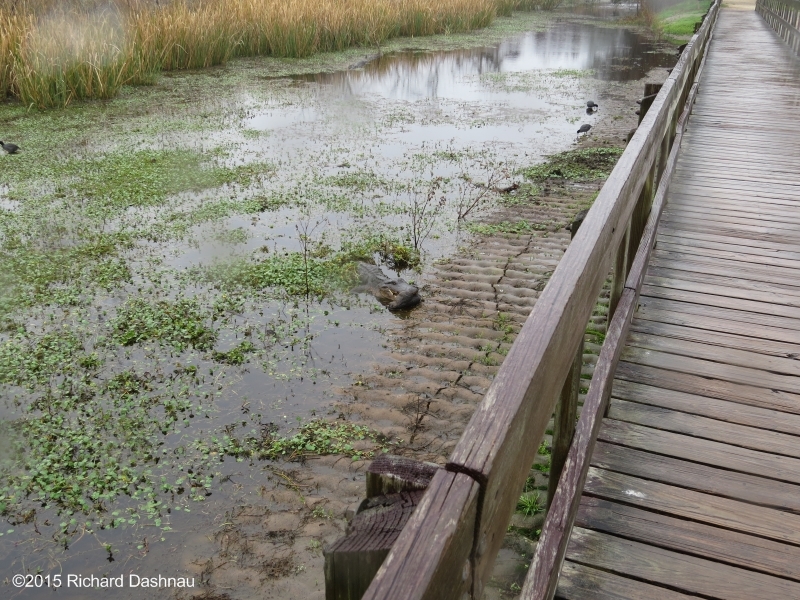
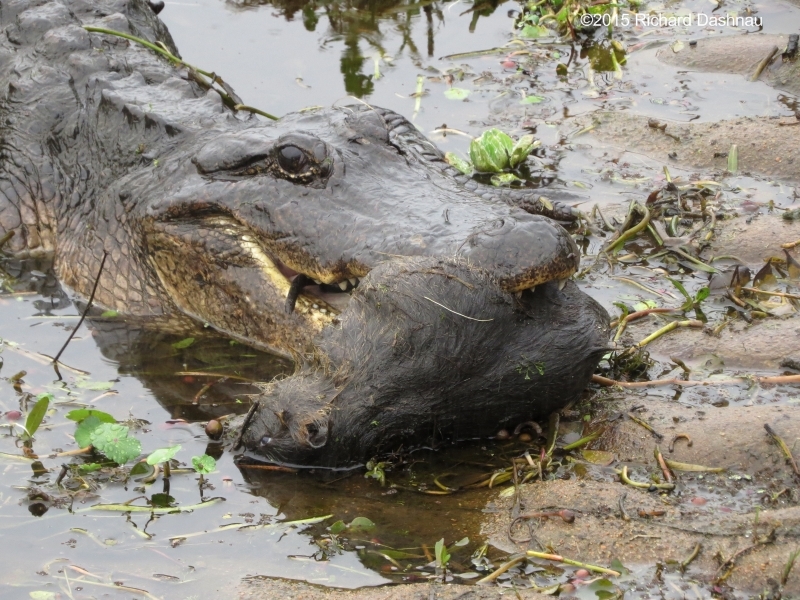

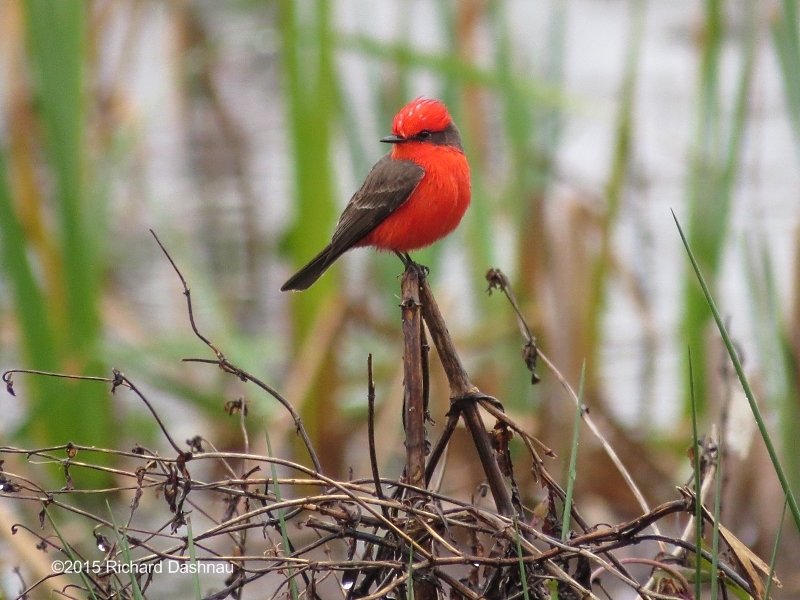
NUTRIA
AT THE BRIDGE
NUTRIA FROM ONE
SIDE
FROM THE OTHER SIDE
Vermilion Flycatcher
April
21, 2013 (update added 6/26/22) An
alligator had claimed the corner of Pilant Lake where the East end of
the Spillway Trail meets Elm Lake. When that happens,
the dominant alligator
chases other alligators--and other animals that are fishing--away from
that area. A week before (April 7th), a park visitor had his backback
stolen
when
he'd left it on the bank while he was fishing. The
alligator followed the fish the visitor had dragged out of the water,
saw the backpack, and grabbed that
instead. It eventually left the backback out in the weeds. The
images
below are photos and frame grabs from the video I filmed. The video is
through this
link (mp4).
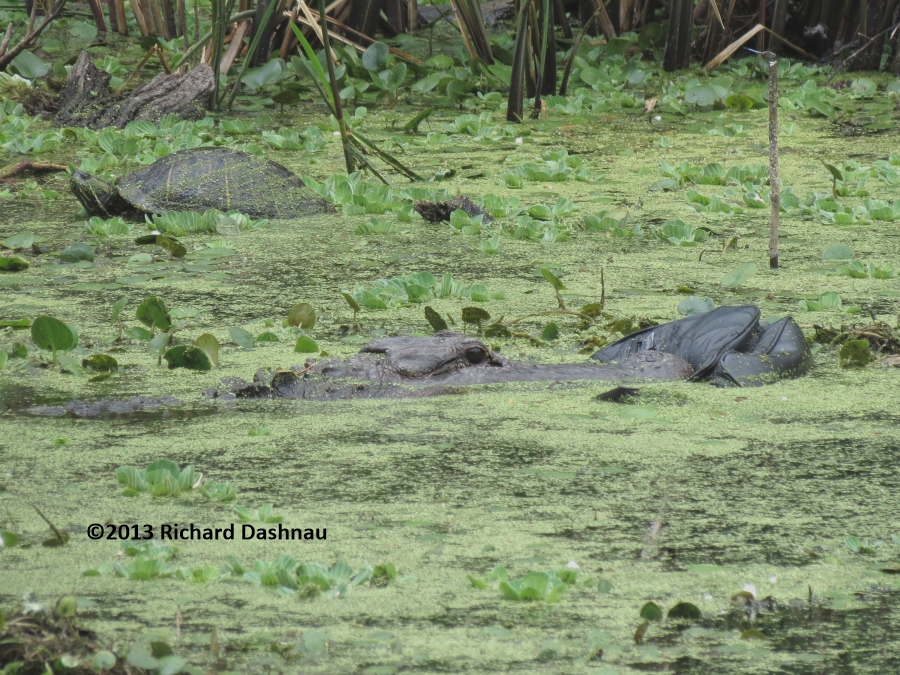
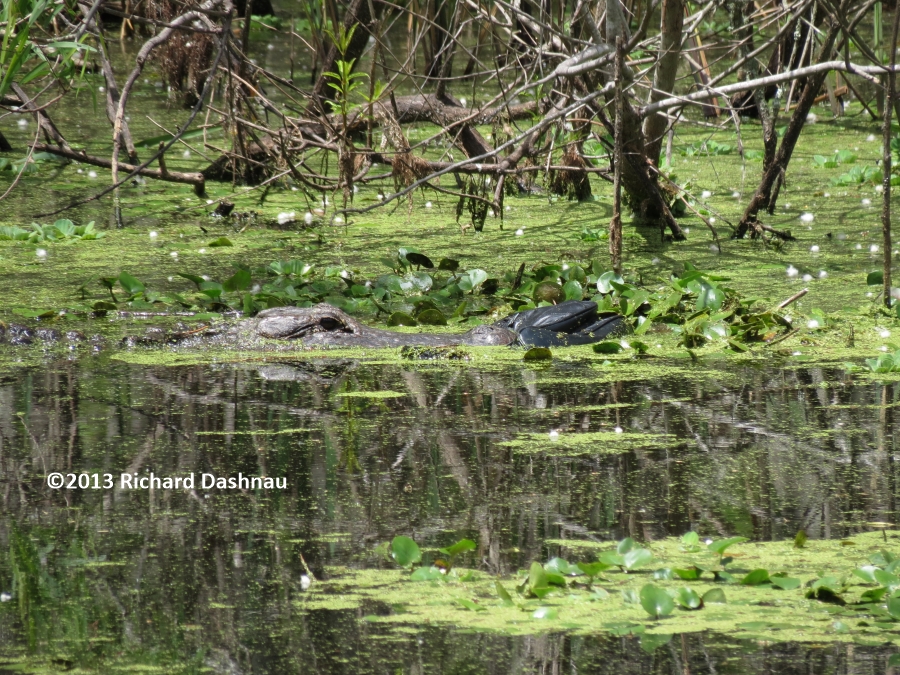
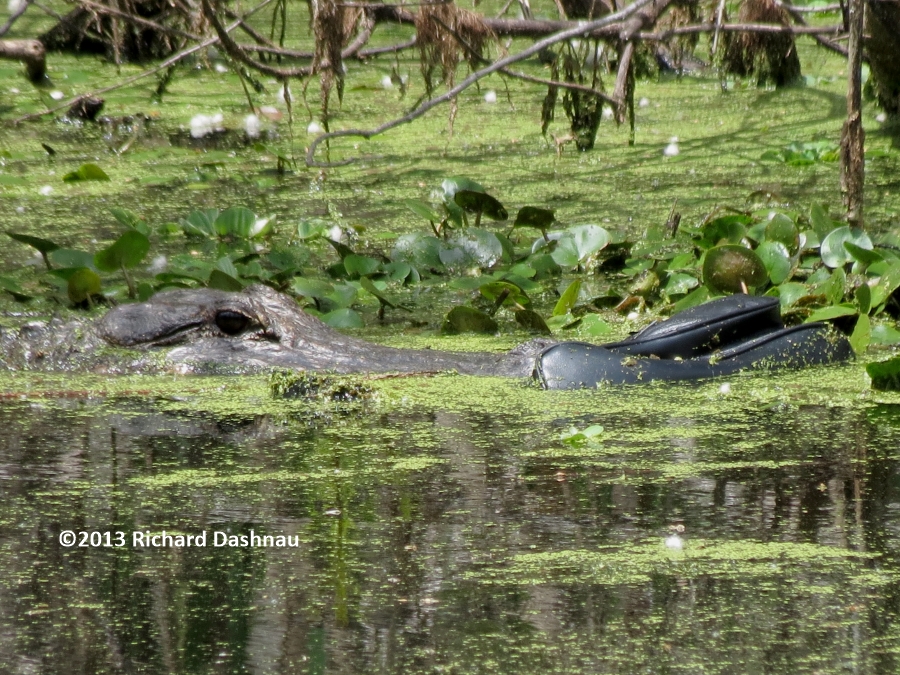
So
today, when I saw the alligator chewing on something dark, I thought
it
had the backback again. That is, until the alligator shook the bundle
and a huge wing
extended. The alligator had a Great Blue
Heron! I've seen alligators chase wading birds out of their
"fishing holes". I watched one alligator follow a Great Blue
Heron-that
had taken a fish out of the gator's puddle-into the woods as the heron
tried to eat the fish. So, I believe that this Great Blue Heron
annoyed
the alligator
enough for the alligator to attack it. The images
below are photos and frame grabs from the video I filmed. The video is
through this
link (mp4).
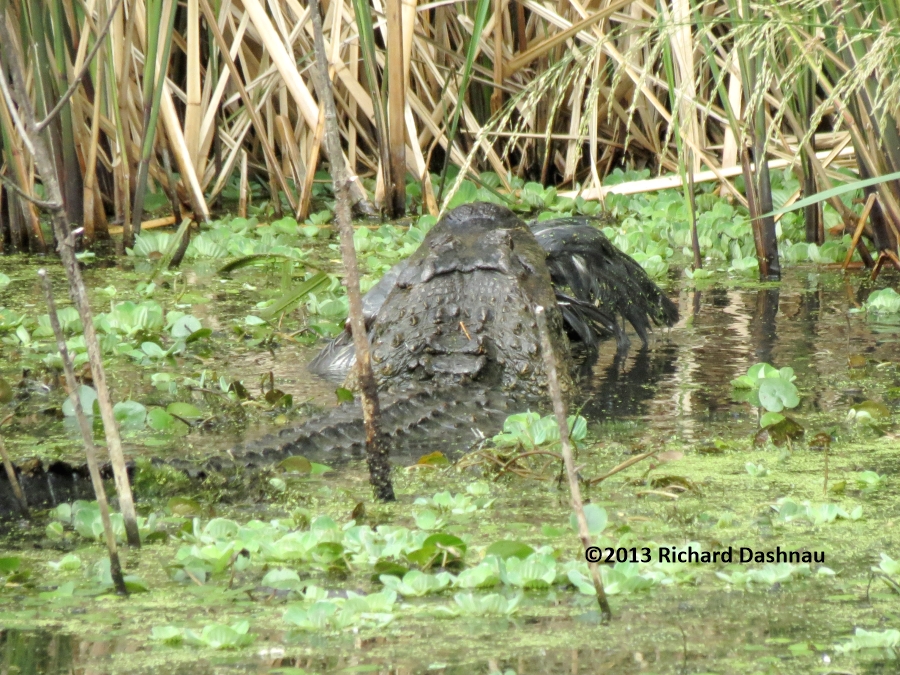
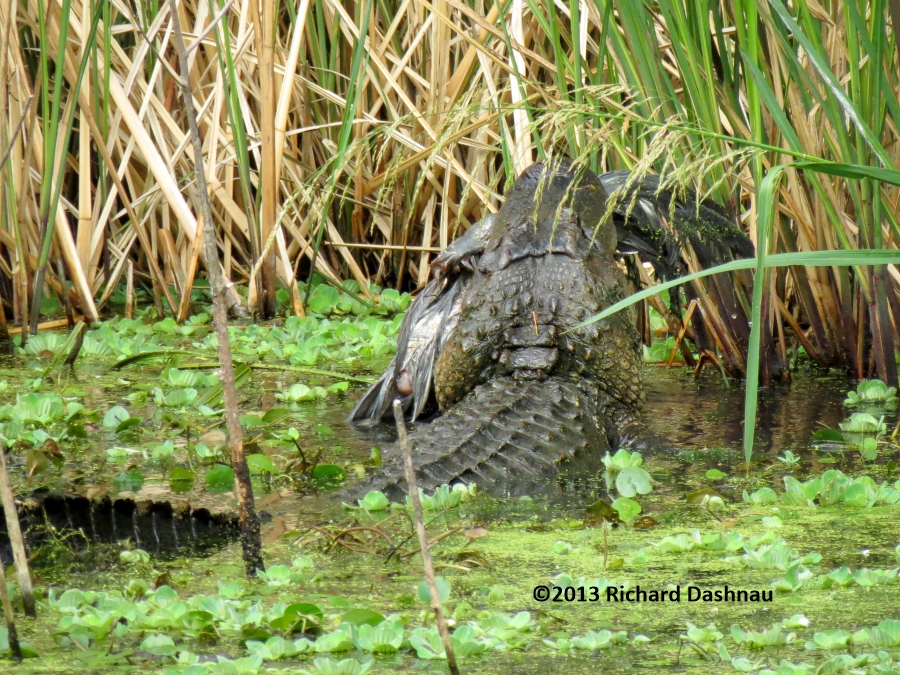
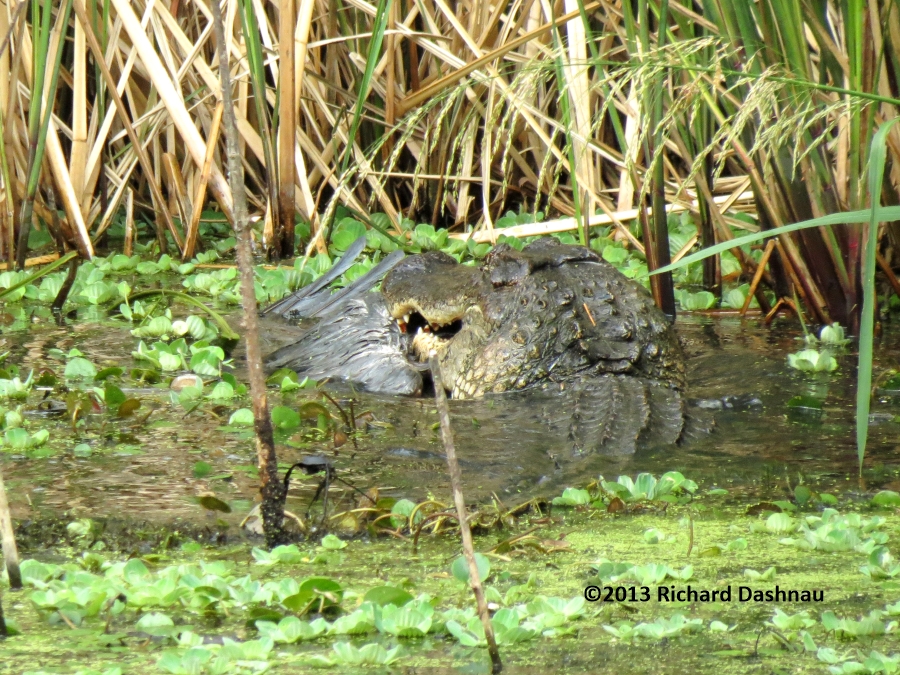
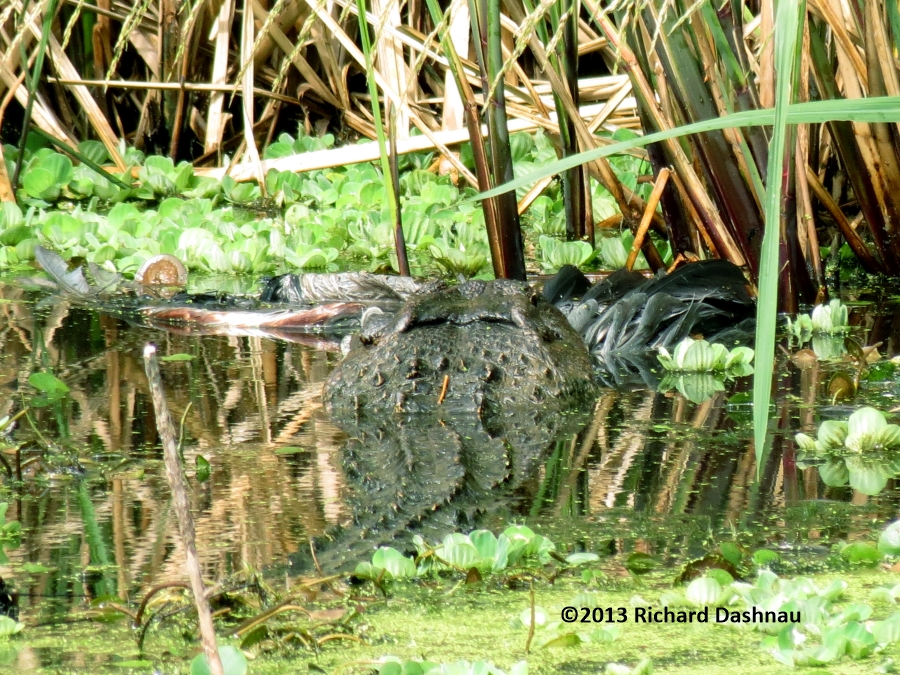
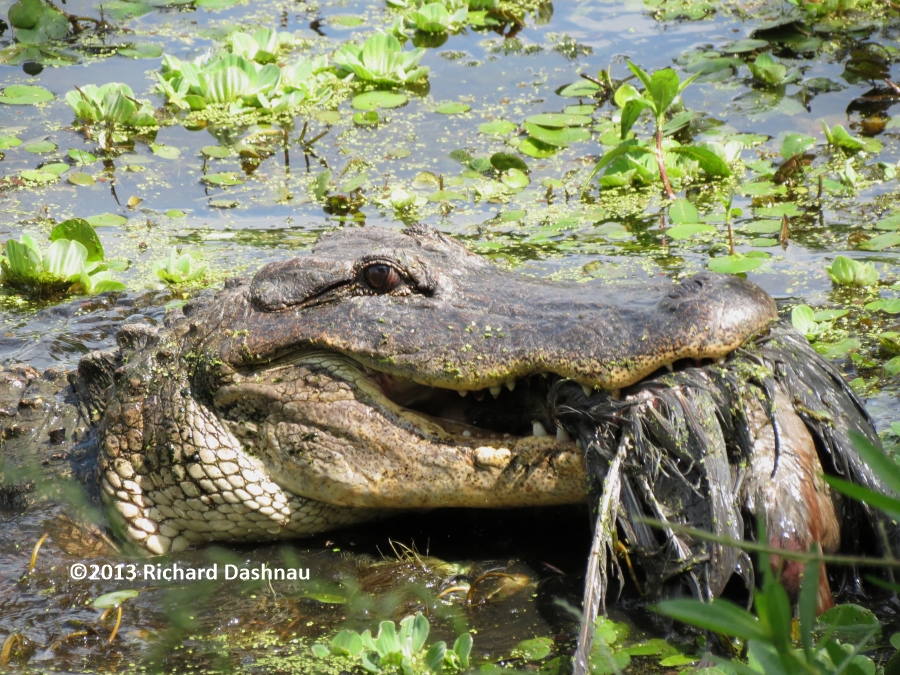
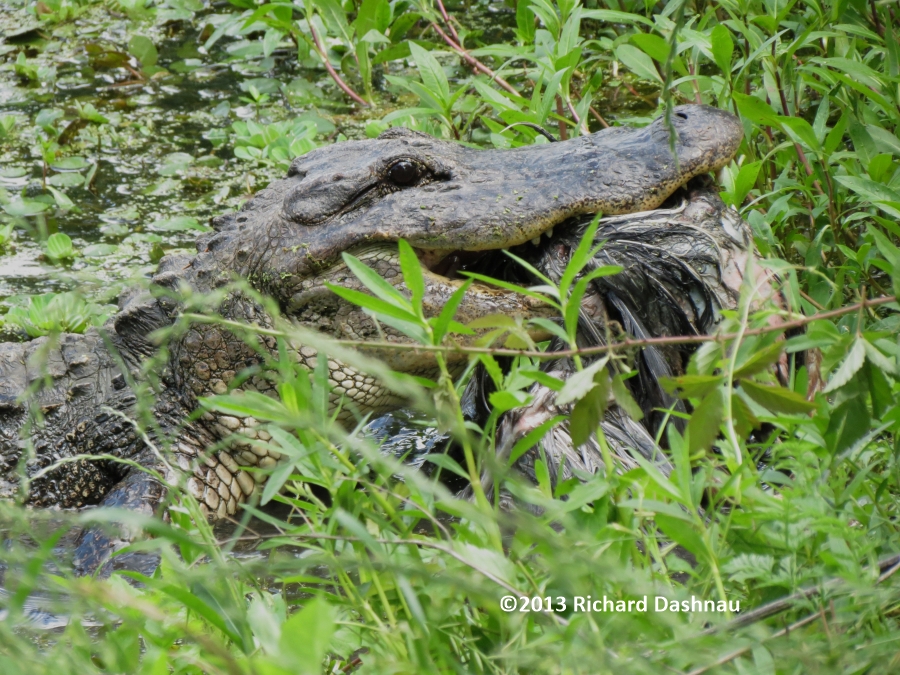
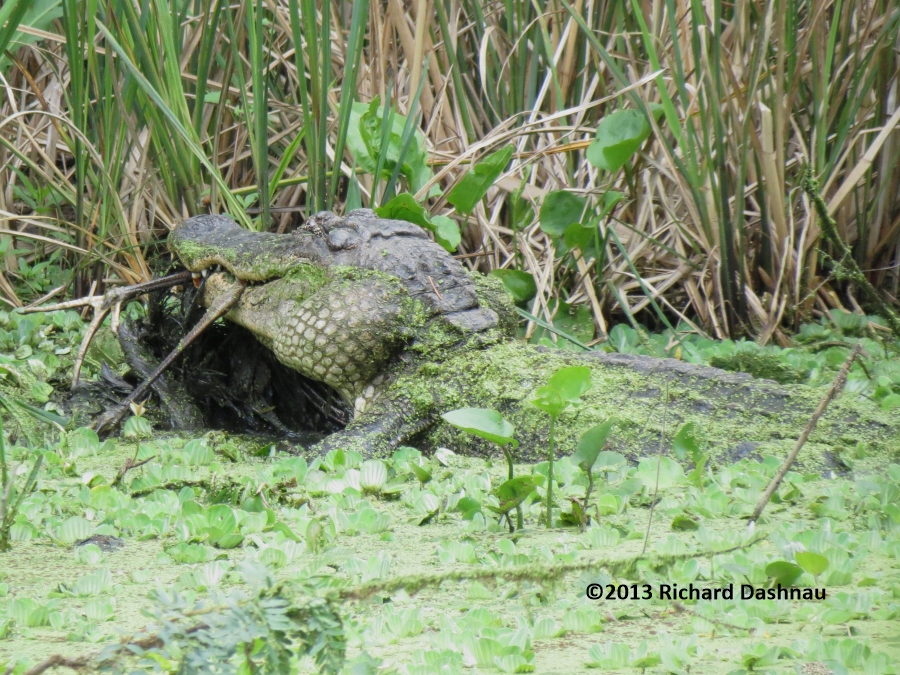
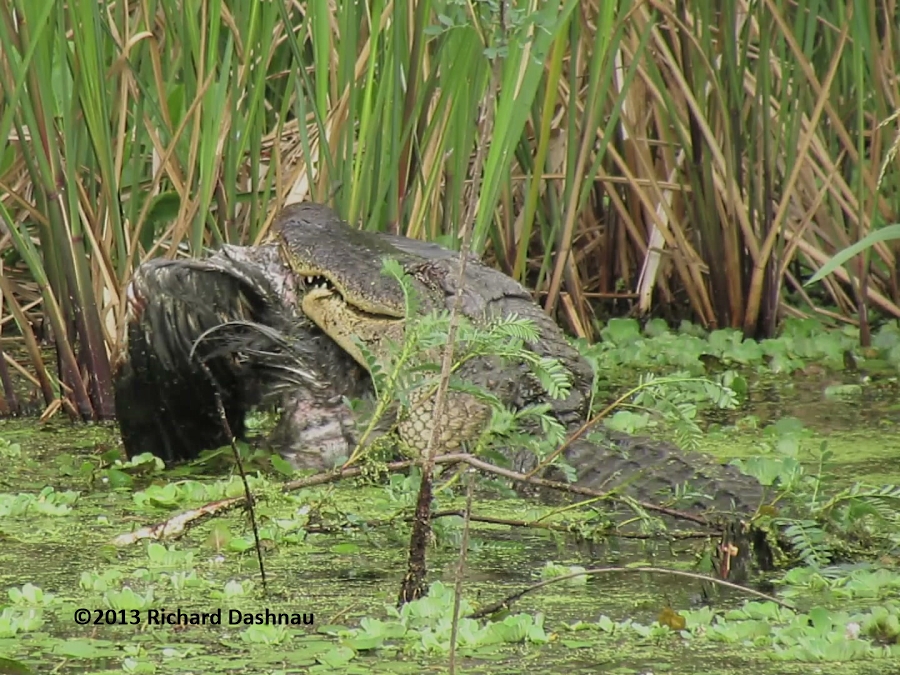
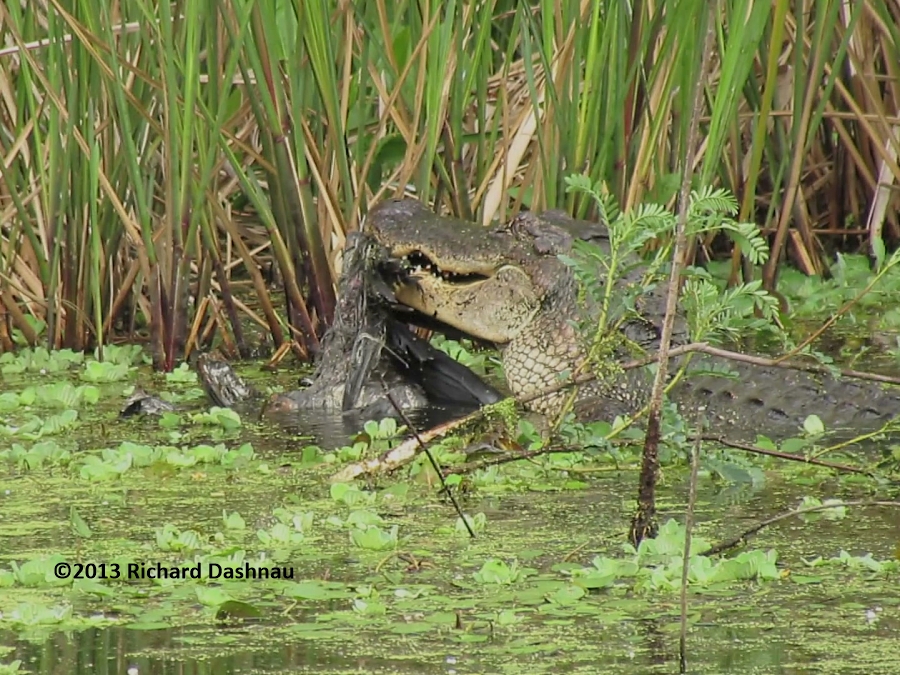
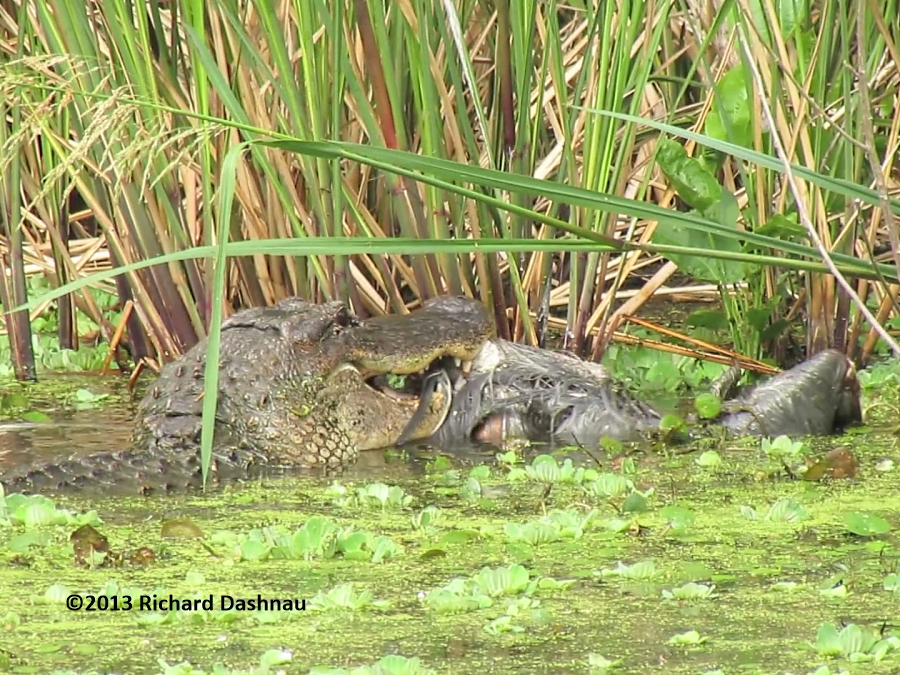
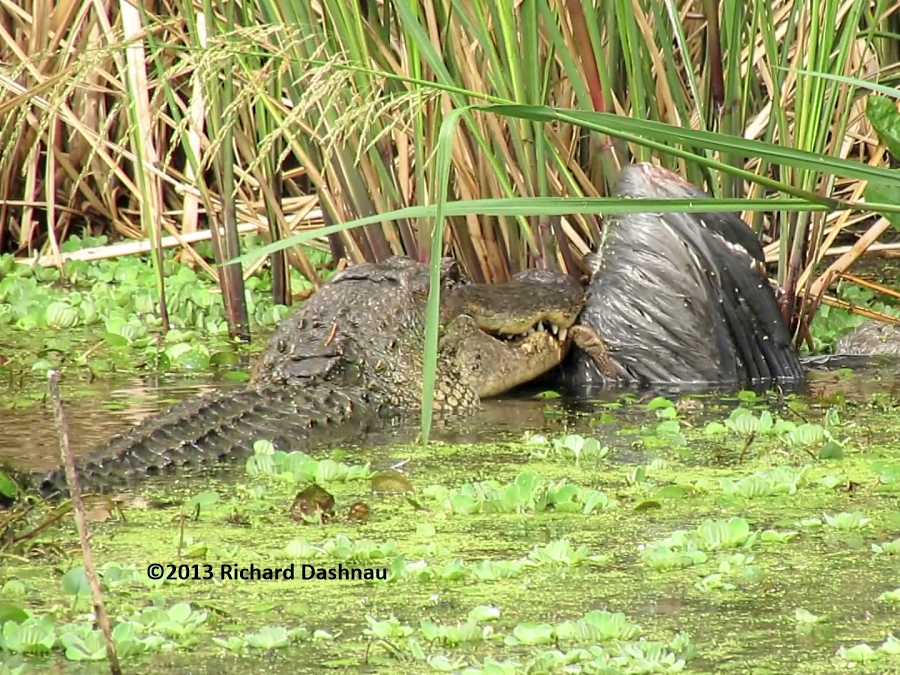
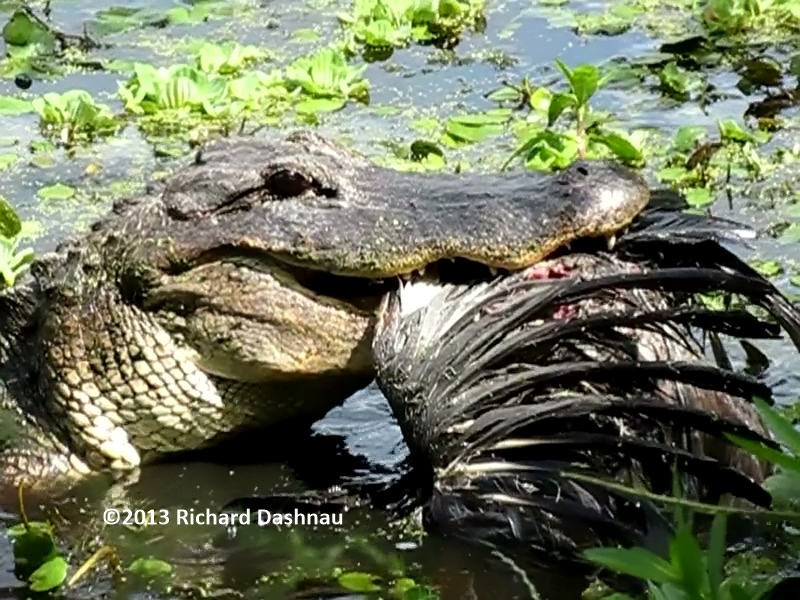
I've
updated the entry for this event in 2022. From the time of this
observation (2013) until now, I've used this event many time to
illustrate a possible path for an alligator's
life. While this event
may seem like a sad end for the Heron, Great Blue Herons are one of
many predators that feed on baby alligators here at BBSP. I've
seen pictures taken
by park visitors of Great Blue Herons, a Great
White Egret, and even an American Bittern carrying baby alligators
away. I've only seen it once, in 2006, captured in a short
video.
I'm working on an update version of that, to include with an
update for the video of this event. The two images below are
frame from that video, showing a Great Blue
Heron with a large baby alligator, just before it flew off when the
mother moved toward it.
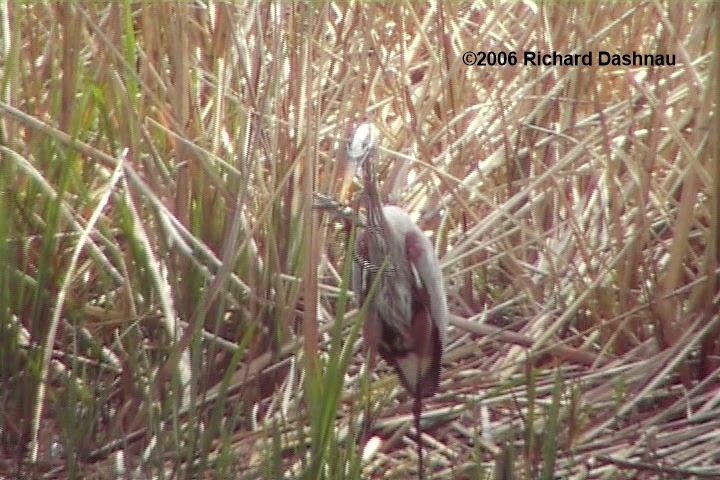
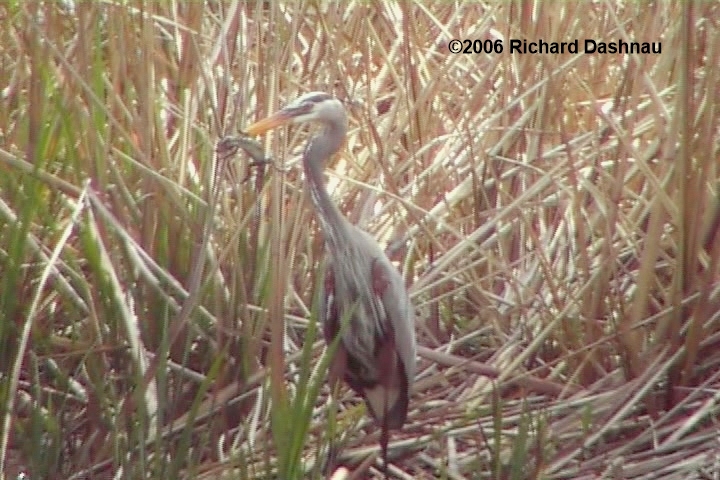
August
28, 2011 As
the water evaporated out of Pilant Lake (and the other lakes, too) at
Brazos Bend State Park through our dry summer, the deeper spots
became
collection areas for all kinds of aquatic life. Or, as it might
sometimes be known...alligator food. The southeast corner of Pilant
Lake (right near the
intersection of the Spillway Trail and the
Elm Lake Trail) remained wet through the entire summer. As the water
evaporated, fish and other life collected
at that Southeast
corner. Through the summer, that corner became a desired feeding
ground
for the alligators. Early in the summer, the corner was claimed
by
an 8-foot long alligator that had a big scar that ran along the left
side of its head, through the eye and into the ear flap. The pictures
below show this
alligator near that corner of Pilant Lake on February 20, 2001--that
is, earlier this year.
----------------------------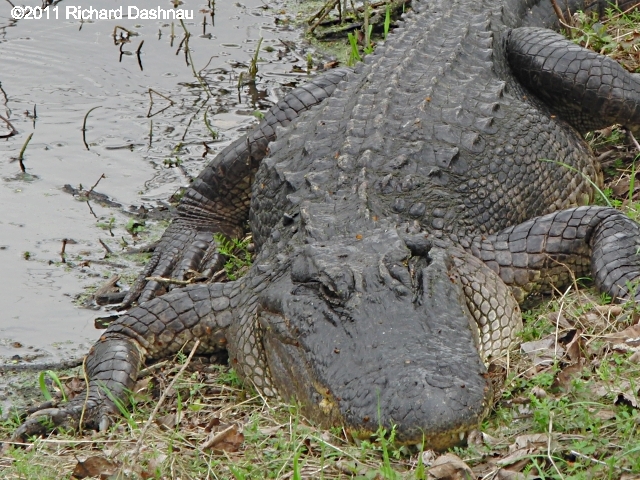 ---------------
---------------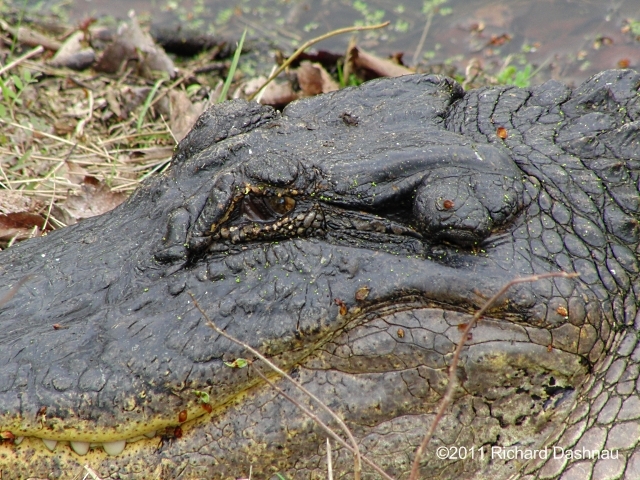
THE SCARRED ALLIGATOR
LEFT
SIDE BLINDED
EYE, DAMAGED EAR
However,
sometime later, "Scar" was chased off by a somewhat larger
alligator--one about 9 feet long. From sometime in June, this larger
alligator
maintained control of the corner puddle as it dwindled
in size. There were a lot of opportunities to watch alligator social
interaction.
As the water became shallow throughout the park the
alligators took advantage of the prey caught in the dwindling pools.
There were many opportunities to
watch alligators trapping food with a technique that I call
"seining". This
page of mine shows the first time I noticed this behavior,
back in 2002 (with some
movie
clips). Basically, the alligator uses its body as a barrier to trap
prey, usually against the bank of a pond; but sometimes the
alligator
will "dam" a
section of water. While using its body as a barrier,
the alligator may also move one of its forelegs (usually the one
closest to the bank) in the water and/or
move its tail. Both of
these motions can herd prey towards the alligator's head. Sometimes
the
alligator will move its tail from side-to-side in the swimming
motion
that normally moves the alligator through the water. But, the
alligator
remains standing, so this movement thrusts the water away from the
alligator--
which generates a current. The alligator sometimes turns
the end of its tail so that the current moves towards the
alligator's
head from the rear; sometimes
it pushes water away to the
rear--but in a small pool, this causes the current to move in a
circle
and towards the front of the alligator's head. Most of the
time
this is an effective technique, since most creatures seem to move
where
the alligator wants them to (which is eventually towards its head
and
jaws).
This leads to my story here. Trapped in the Southeast Corner
of Pilant Lake were, among other things, a bunch of gar. These
appeared to be longnosed gar
...but there may have been some spotted
gar as well. Gar, seem to be a bit more crafty than most other fish,
as
shown here. Although the gar *were* being
herded to some extent;
beyond a certain point they figured out that they could get past the
alligator. They would do this either by swimming *up onto the
mud*, and then past the alligator; or...by simply jumping over
the alligator! I caught some of this activity in video with the
high-speed camera. Although
the
alligator was successful sometimes--sometimes it was not. At least,
while there was still enough water for the gar to swim in. The
images
here are frame
captures from some of the video. And, here is the video
clip (mp4). I enjoyed watching the daredevil gar.
---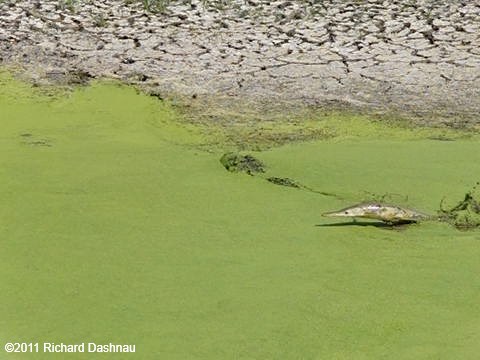 -
-
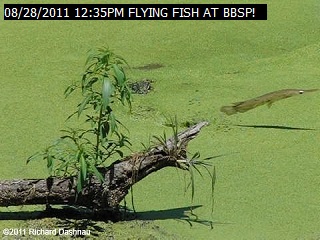
ESCAPE OVER THE TAIL
Here,
the alligator was blocking off a narrower section of the pool. It
moved
its tail, and occasionally the right foreleg to flush the fish and
panic them
enought to try to swim past the alligator's head. This gar
jumped over the safe
end.
-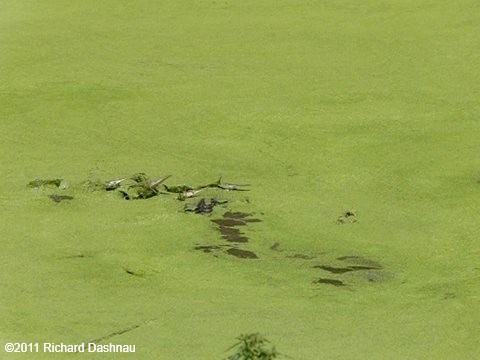 --
--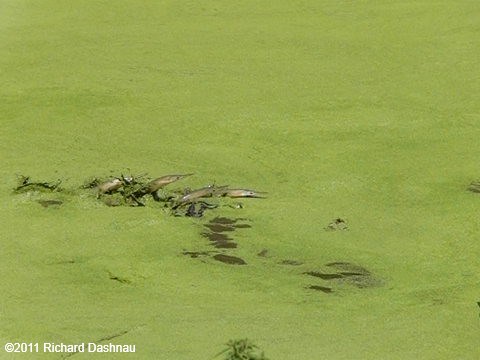 --
--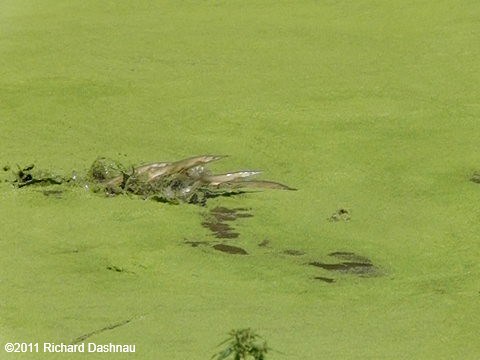 --
--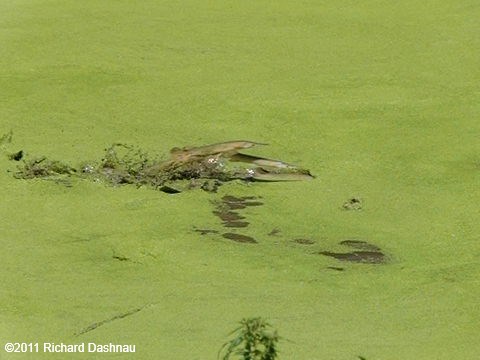
JUMPING
GROUP OF GAR 1
JUMPING
GROUP OF GAR 2
JUMPING
GROUP OF GAR 3
JUMPING GROUP OF GAR
4
The alligator
would
sometimes go into the deeper spots to flush fish towards the
shallower edges. Then it would move towards the edges.
The gar had
other ideas here. Instead of swimming away in panic, a group of them
jumped over the alligator's back. This group of 7 images
shows the jump.
---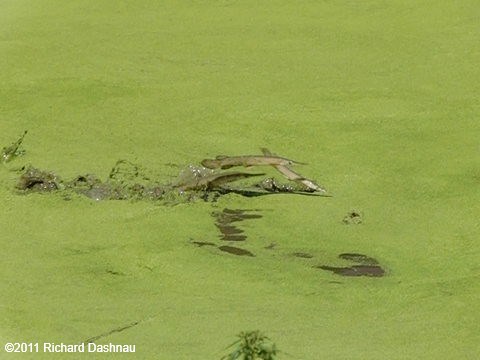 --
--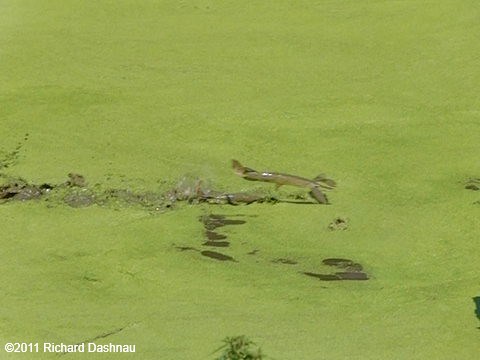 --
--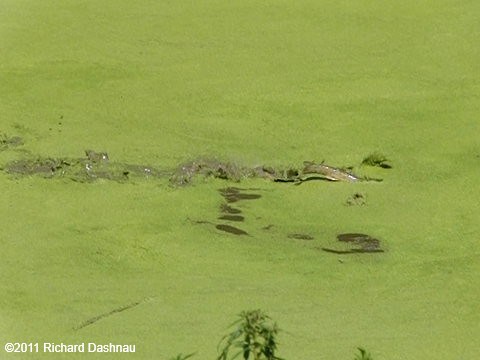 --
--
JUMPING GROUP OF GAR
5
JUMPING GROUP OF GAR
6
JUMPING GROUP
OF GAR 7
---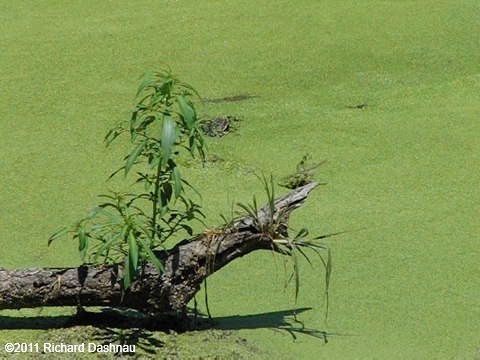 --
--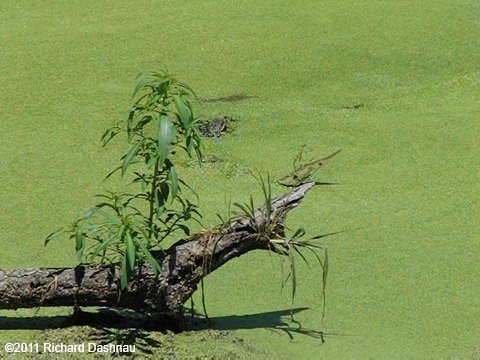 --
--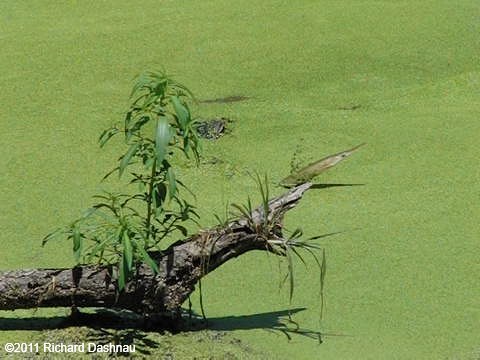
FLUSHED FROM BEHIND
1
FLUSHED FROM BEHIND
2
FLUSHED
FROM BEHIND 3
-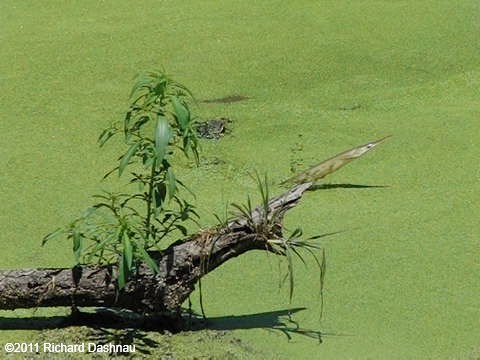 --
--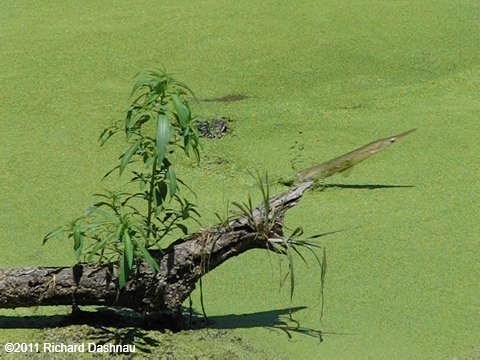
FLUSHED FROM BEHIND 4
FLUSHED FROM BEHIND
5
After
stirring things up in the deeper water, the alligator moved
towards the edge to see what moved there. It was on the tail of a gar,
but
not for long. It might possibly have caught the gar...if the gar
hadn't
left the water! This group of 9 images shows the jump.
-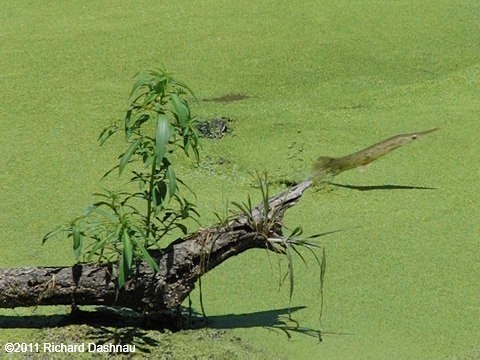 -
-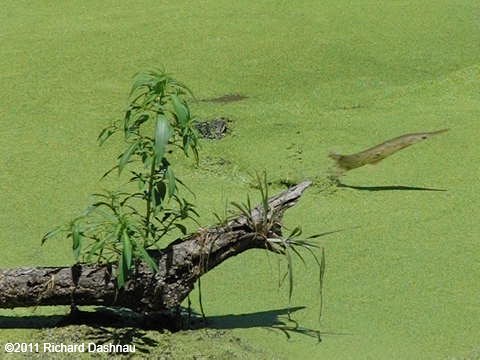 -
-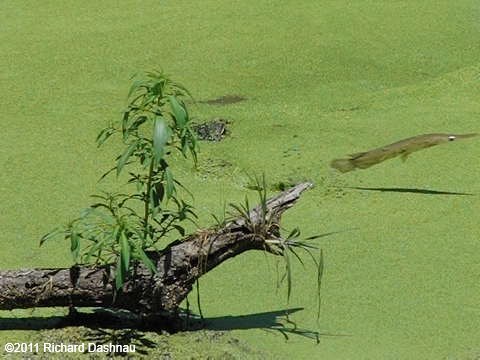 -
-
FLUSHED FROM BEHIND
6
FLUSHED FROM BEHIND
7
FLUSHED
FROM BEHIND 8
FLUSHED FROM BEHIND
9
These last 3 images show the alligator encircling an area with its
body, tail, and head! In the video, trapped critters
can be seen moving around in the trap. As the alligator turns its
head, ready to close the trap, this gar leapt over
the "seine" to safety. One can see in these images (and in the clip)
that this alligator has a good left eye. (unlike the
scarred one, above). Once again, here's the link to
the video
clip (mp4).
---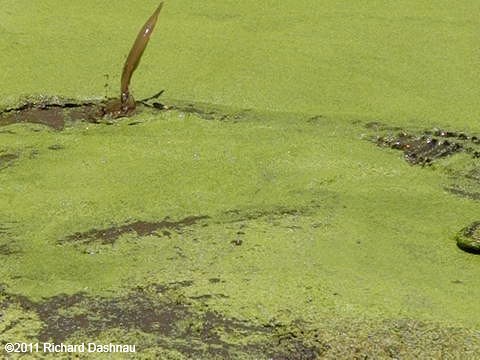 --
--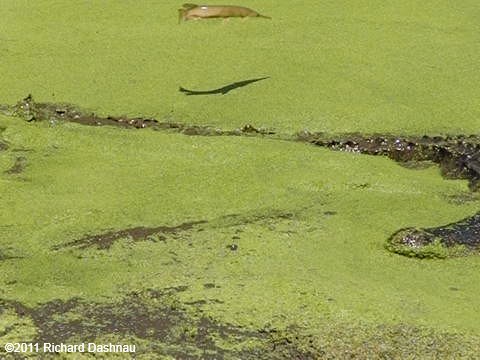 --
--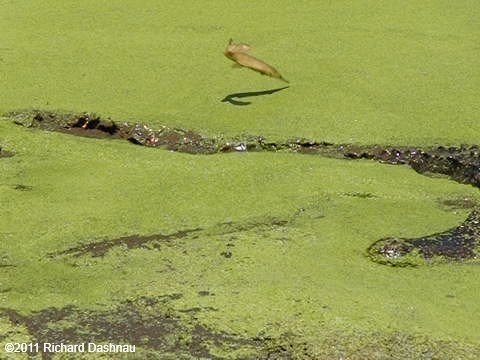 --
--
February
6, 2011:
Everyone
is probably aware of the recent bout of cold weather we've had.
Starting sometime Thursday, the temperature dropped from around 69
degrees F to somewhere
in the 20's--and stayed there through Saturday,
night. Sunday morning still had temperatures in the 40's, although by
afternoon it got up to 70 degrees.
Sunday
morning, Feb.6, 2011, while it was still cold, I saw an alligator at
the Spillway. The alligator had a nutria in its mouth. Since water was
flowing over the Spillway, and with the alligator there
; I closed the
gates at both ends of the bridge. I've
read
that alligators can't digest if their core temperature falls below
70 deg. F. As I mentioned above, air temperature was well
below
that for
about 3 full days and nights. It's hard for me to believe that
the water temperature anywhere was much higher than that, even in the
deepest spots. So, the alligator must have been cold. This is
also the extremely
thin alligator that's been in that area for some months. And,
the alligator is *blind* in both eyes! How did it catch the
nutria in the first place? Today's RICKUBISCAM shows
that alligator,
illustrating the prominent
backbone.
The stick on its head is most likely there by accident. I've often
seen
alligators with such "headgear". This can happen if they surface under
a
random piece of floating debris. The images below
show the alligator face in closer, and a close up of the face
to show that the eyes are gone.
---------------------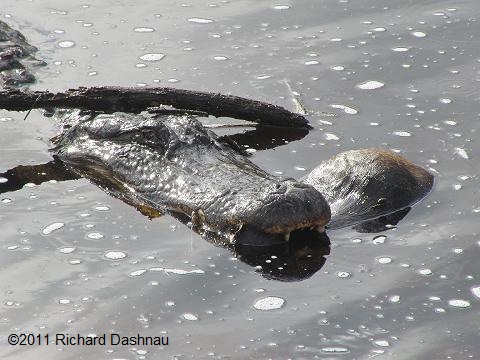 --------
--------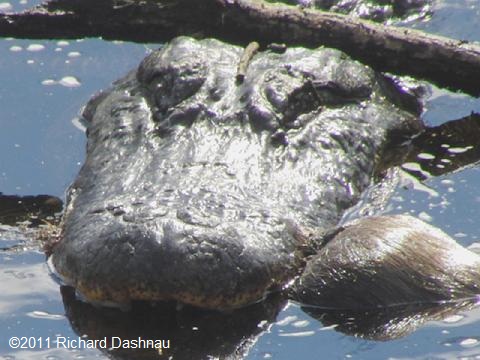
I
thought this was an
interesting mystery. So, I looked again at information on how
alligators control their temperature. I
found these two studies about alligator thermoregulation. There are a
lot
of factors that influence the internal temperature of an alligator.
Besides the general weather factors (sunlight, temperature) there is
the alligator's external behavior (moving in and out of the
water,
turning towards the sun, gaping) and internal behavior (circulation,
respiration, and metabolic movement) and various other factors.
Temperature exchange happens faster in water (since it
conducts heat
better than air), but it is a more stable thermal environment
than air;
and is slower to change condition. So, alligators use water as a
temperature buffer. An
alligator
heats up faster
than it cools off (at least larger ones
do--small ones heat and cool at the same rate). Alligators are
efficient heat pumps.
This
still doesn't explain what the alligator was doing with the nutria
last
weekend, and HOW it got it in the first place.
The links: thermoregulation
1
thermoregulation 2
And,
this
page shows alligators at the park, on land, near various landmarks
at the park.
Go back to my main alligator
page, Alligators
Go
back to my home page, Welcome
to rickubis.com
Go
to the main
alligator page












































































